 |
|
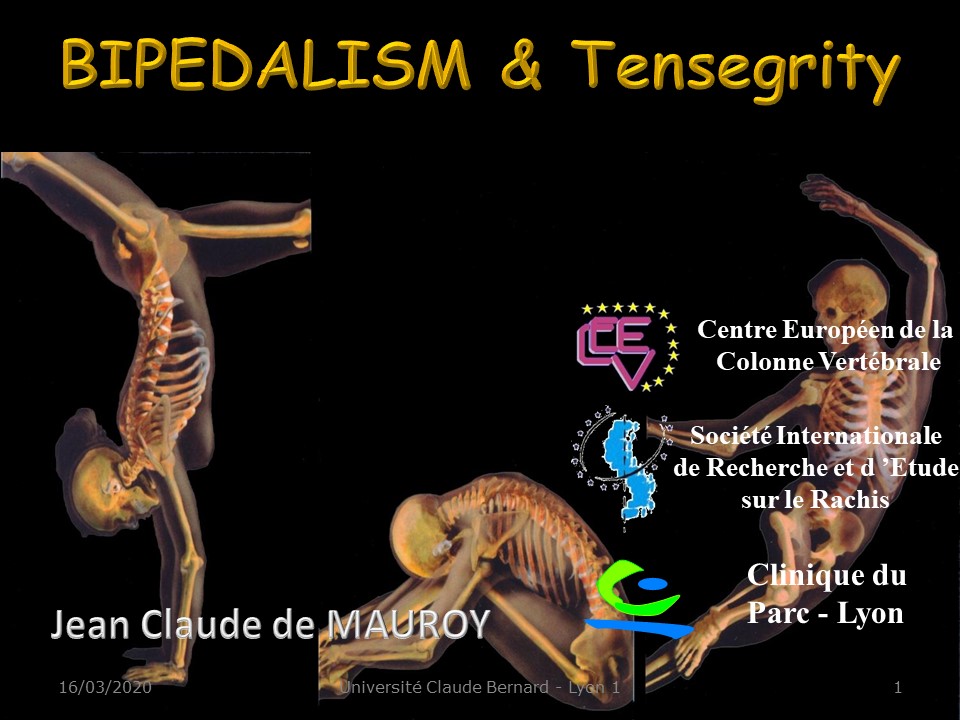 |
Scoliosis, the shame of orthopedics, is the most difficult vertebral deformity to apprehend. It is the consequence of homo sapiens bipedalism.
|
 |
.
|
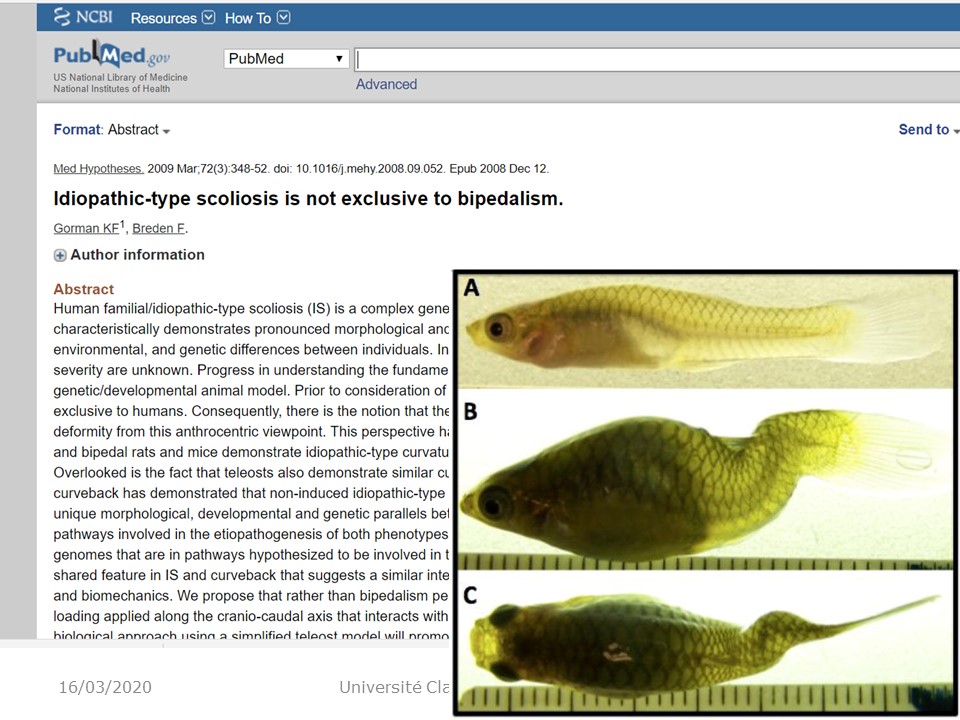 |
Some publications find scoliosis in fish as here Guppy.
|
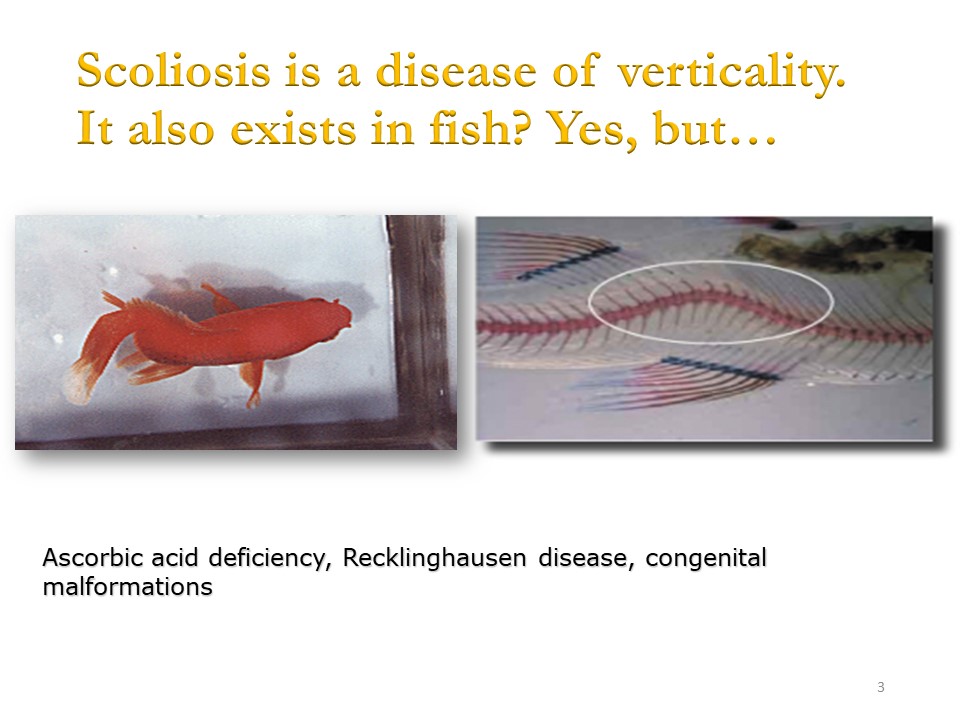 |
If so-called "idiopathic" scoliosis is one of the characteristics of bipedalism, it is also seen in fish, but it is not about idiopathic scoliosis. Most of the time, it is a congenital vertebral malformation. There are also neuro-ectodermies in some species of fish or deficits in ascorbic acid.
|
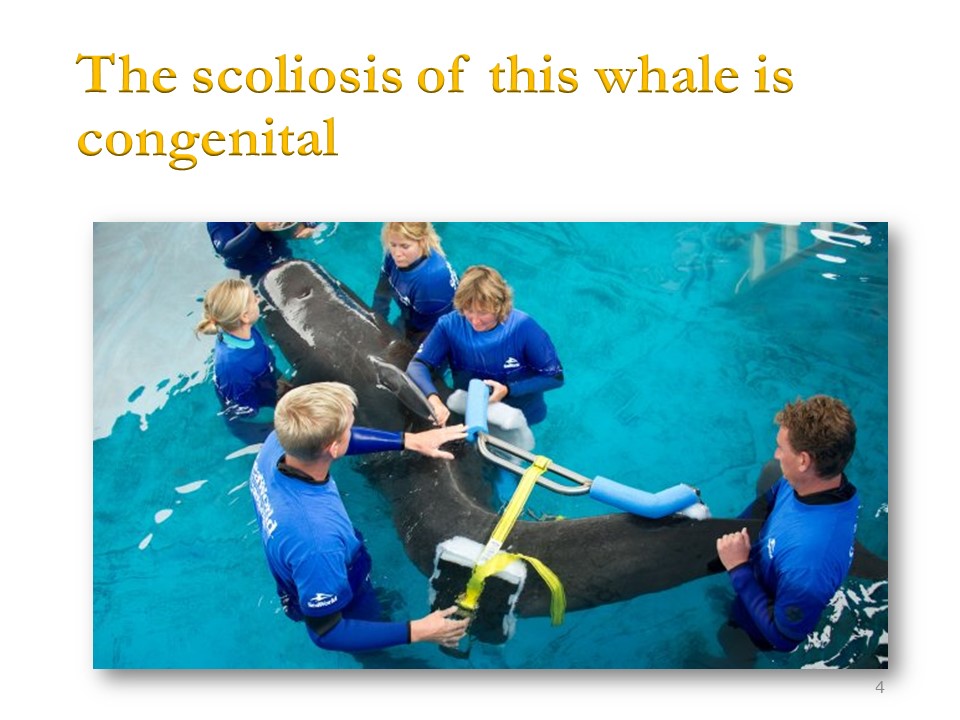 |
In this calf, the malformation is congenital. Like all mammals, the plane of function being the sagittal plane, it is difficult to swim.
|
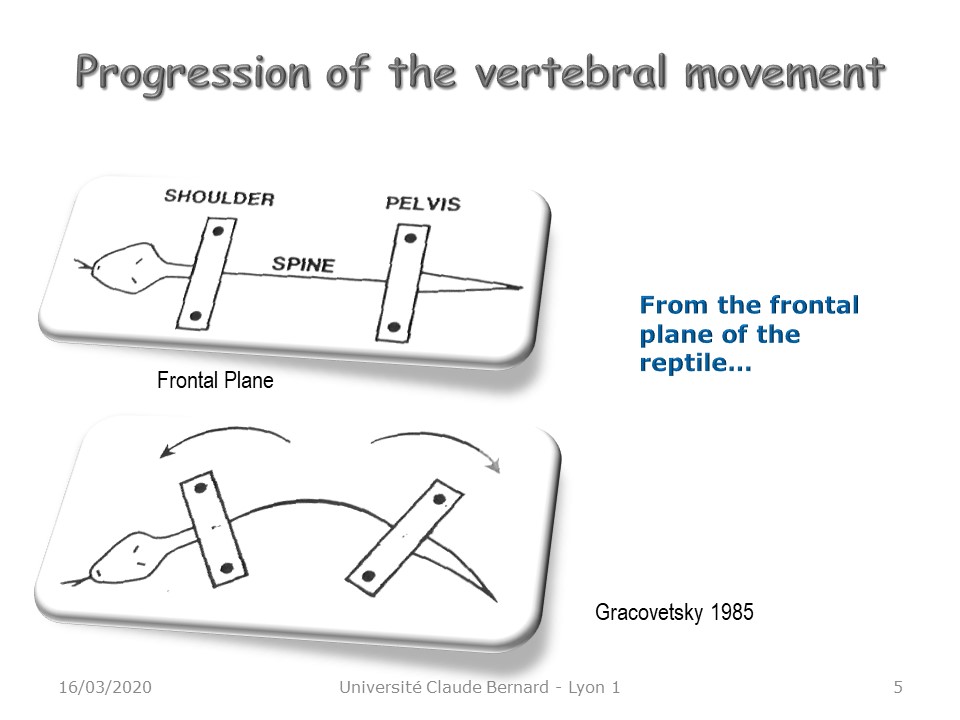 |
Initially, the first plane of function for reptiles and dinosaurs was the frontal plane. The actual snakes keep this locomotion mode
|
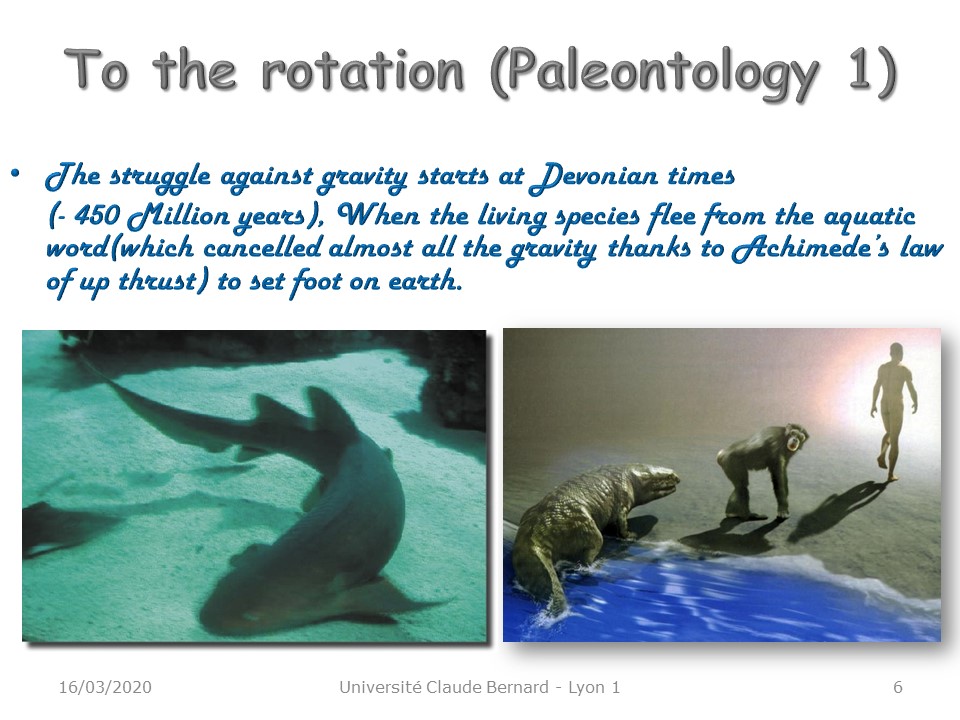 |
Archimede’s up thrust which cancels almost all the gravity disappears. The anti gravity struggle compel them to crawl, facing the ground, flattered by their volume. Therefore, they have to push laterally on their extended legs in order to free their ribas and to breath properly.
|
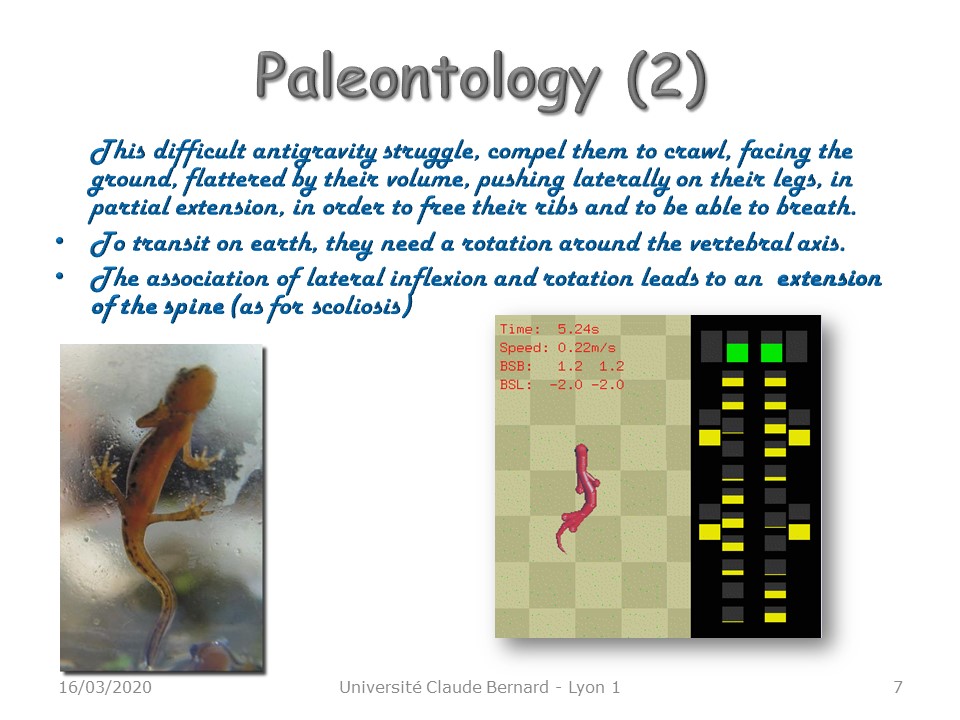 |
To move on earth, they need a rotation around the vertebral axis.The association of lateral inflexion and rotation leads to an extension of the spine (as for scoliosis)
|
 |
It is the movement of the spine in a sagittal plane which is going to allow the progressive development of the inferior limbs. The muscles are going to migrate out of the abdominal wall. The increase of the volume of the muscle structure of the inferior limbs enables the bipedalism.
|
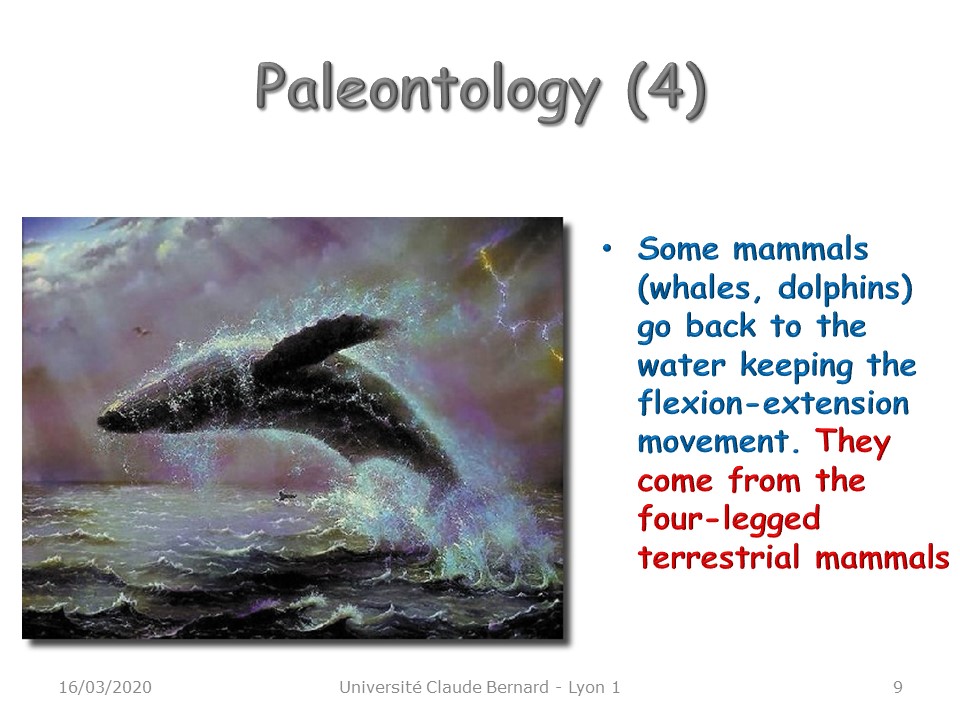 |
Some mammals (whales, dolphins) go back to the water keeping the flexion-extension movement. They come from the four-legged terrestrial mammals
|
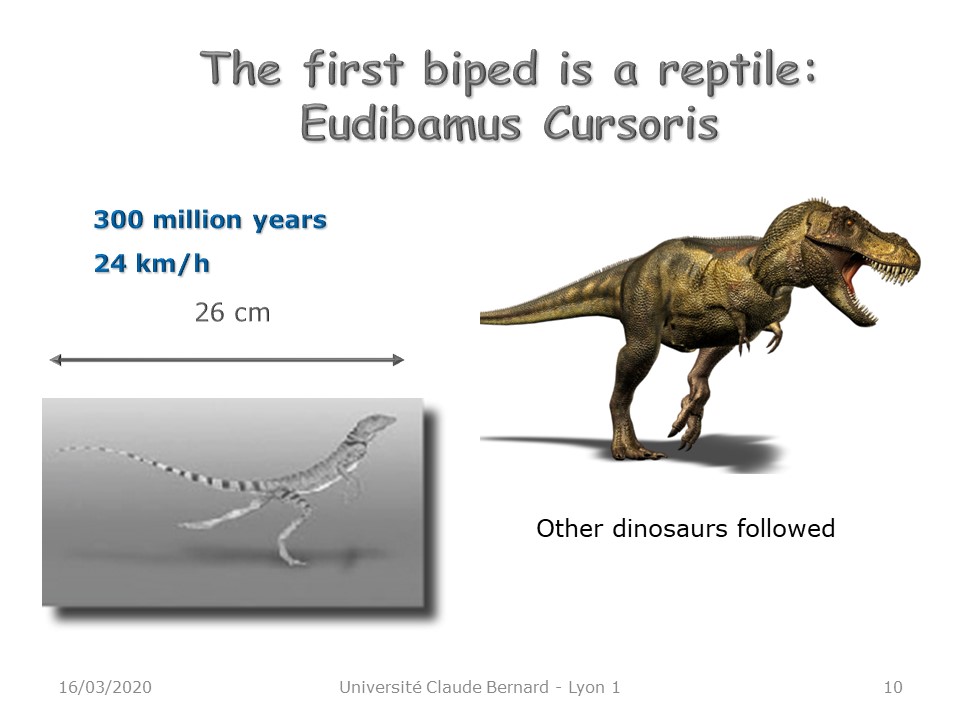 |
The first biped 300 million years ago is a little dinosaur: Eudibamus Cursoris
|
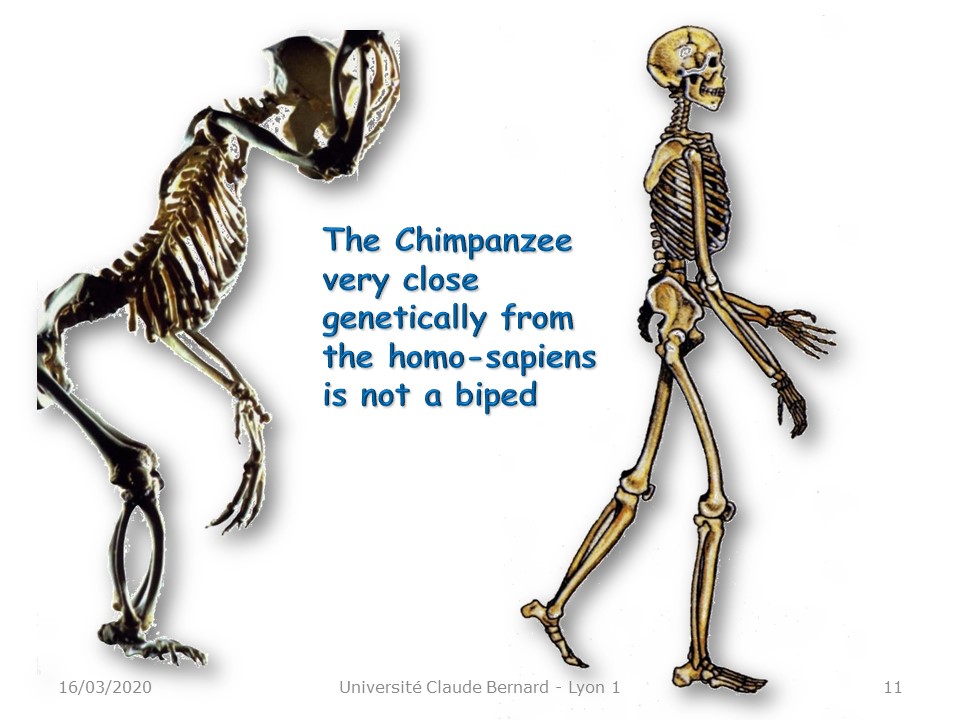  |
Australopithecus apes will gradually become vertical. The chimpanzee is probably the closest genetically to homo sapiens with a genome variation of 1%; but he is not a real biped,
|
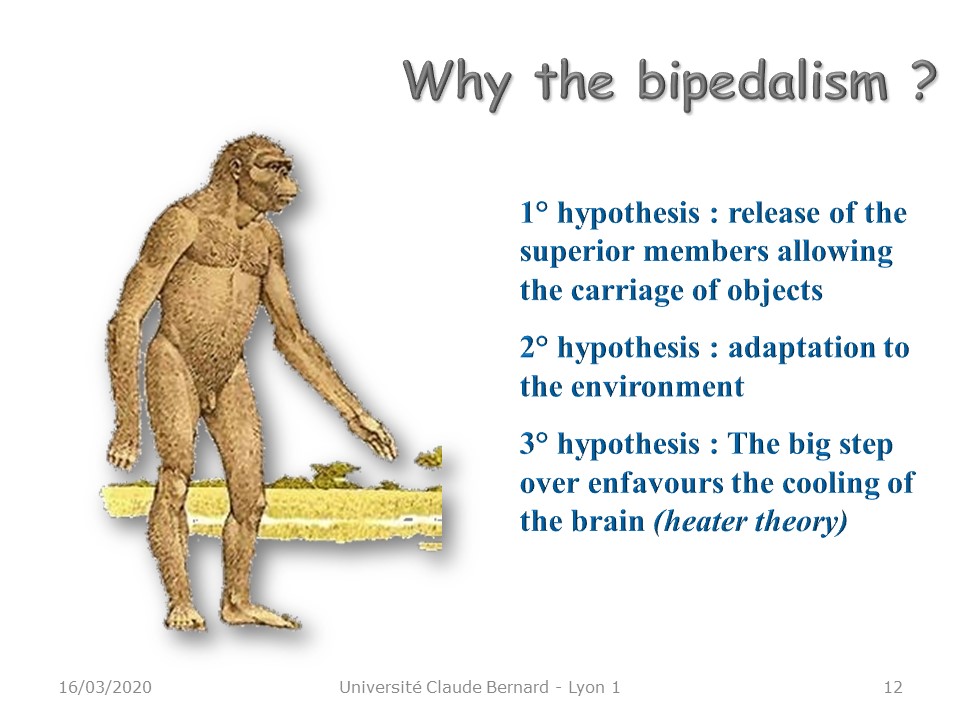 |
The first ascertainment is that bipedalism free the superior limbs, allow the carriage of objects and a specialization; especially with the thumb-index pinch which did not exist at Neanderthal time, but existing at homo-sapiens time.The second hypothesis is the one developed by Yves Coppens in « east side story». The insulation of a part of Africa thanks to the rift, modified the climate transforming the forest into savannah. The need to see from far away above the high vegetation may have helped. But many bipeds older than Lucy have been found in West Africa.The third hypothesis is about energy. The Neandertal man had a really thick bone cortical and therefore less medullary, less blood and less energy. To transit from cold-blooded reptile to warm blooded an air conditioning is necessary. The head and the hair are an air conditioning helping the head to evacuate.
|
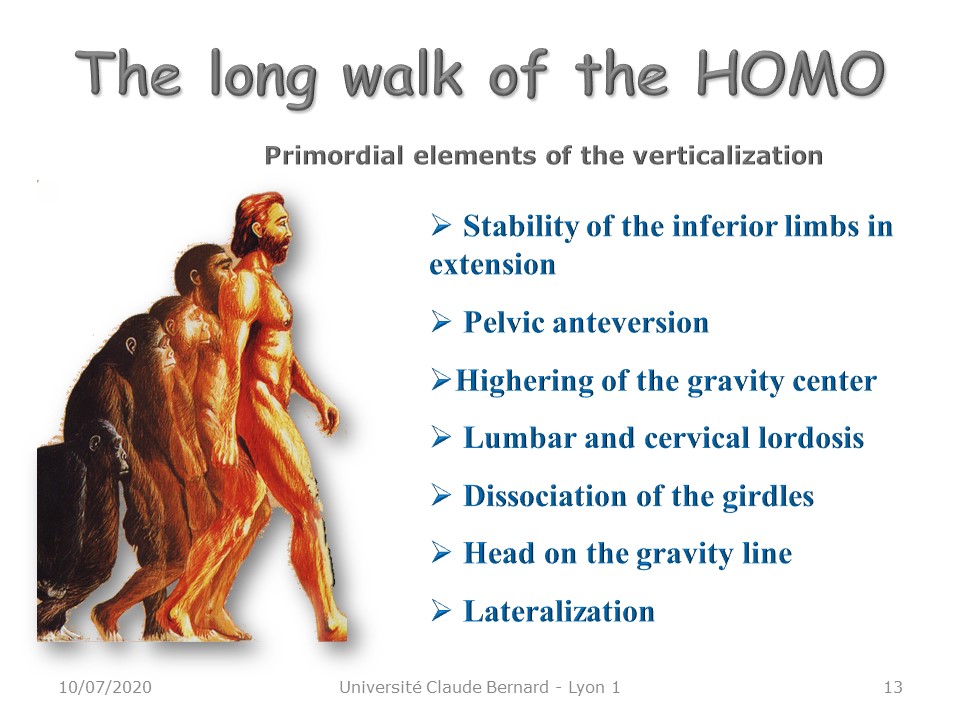 |
The primordial elements of the verticalization are: Stability of the inferior limbs in extension, Pelvic anteversion, rising of the gravity centre, Lumbar and cervical lordosis, Dissociation of the belts, Head on the gravity line and Lateralization.
|
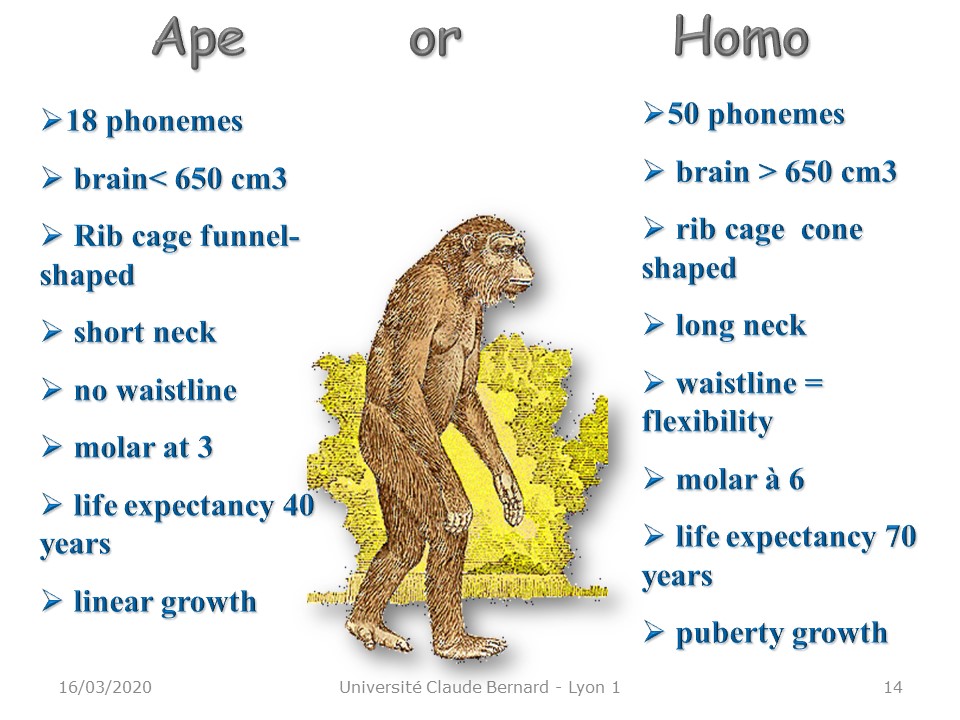 |
The main evolutions are: at the level of the language with increase from 18 to 50 phonemes. The size of the brain is also increasing. The volume of the rib cage changes. The neck lengthens. The waistline appears with the 3D flexibility. The number of molars increases as well as the life expectancy. Puberty growth accelerates height growth.
|
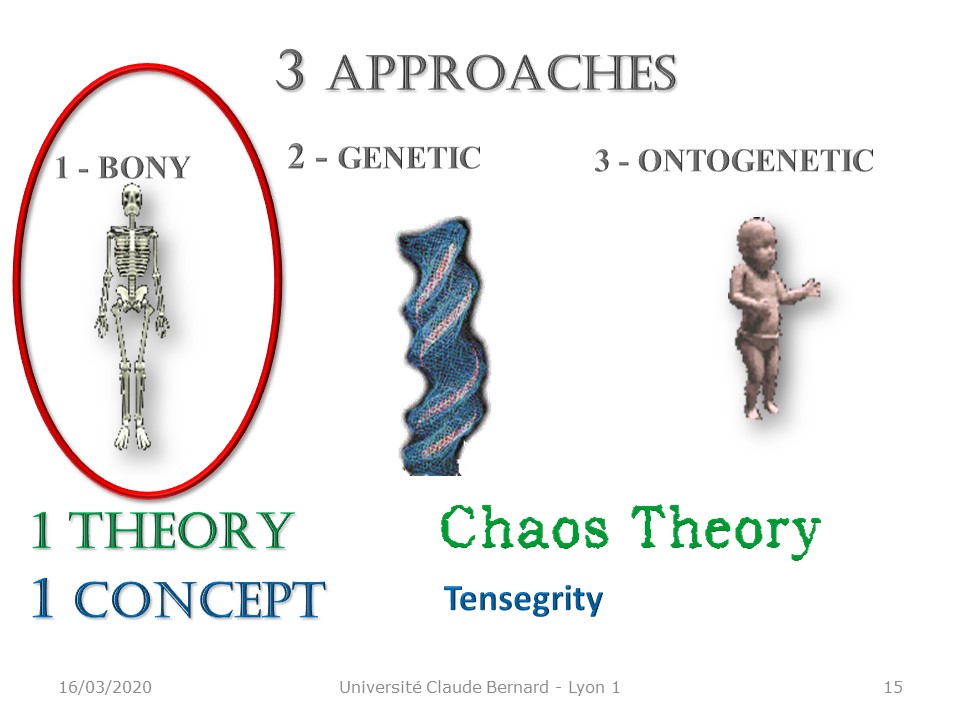 |
In this module, we will consider one of the first paleo-anthropological approaches focused on bone evolution.
|
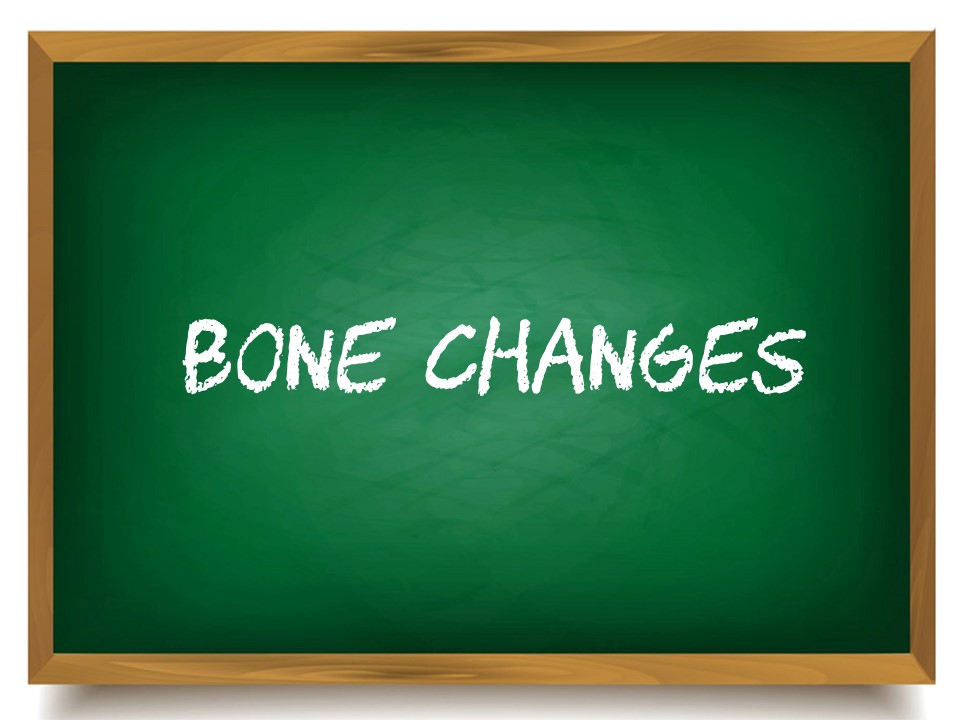 |
.
|
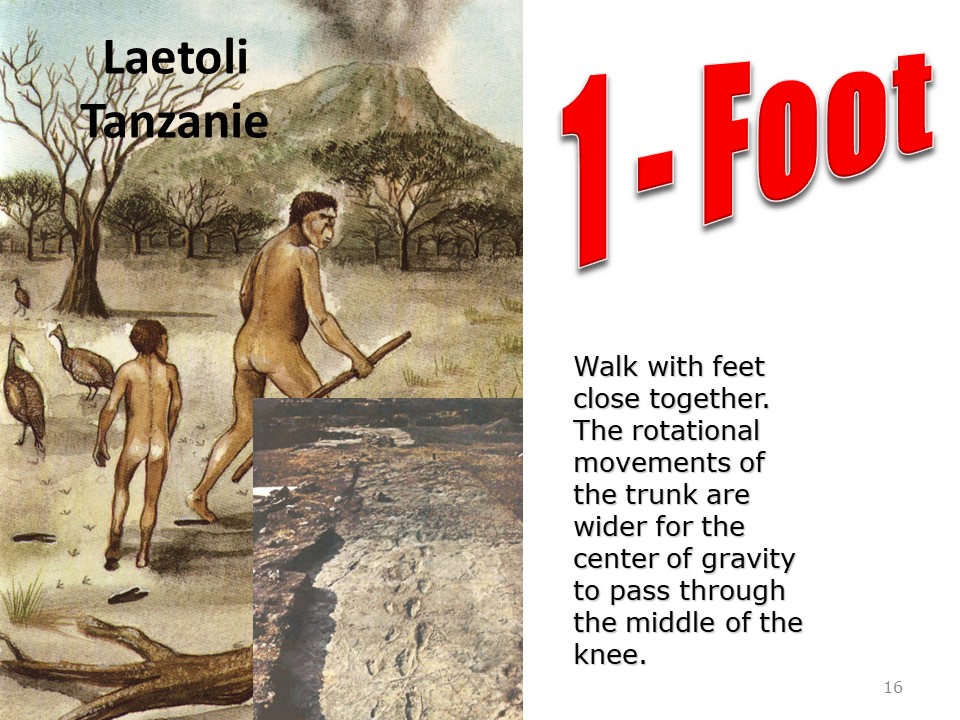 |
The first signs of bipedal footprints were discovered by Mary Leakey in the ashes of the Laetoli volcano in Tanzania. They date back to 4 million years ago. Walking is done with feet close together.The rotational movements of the trunk are wider for the center of gravity to pass through the middle of the knee.
|
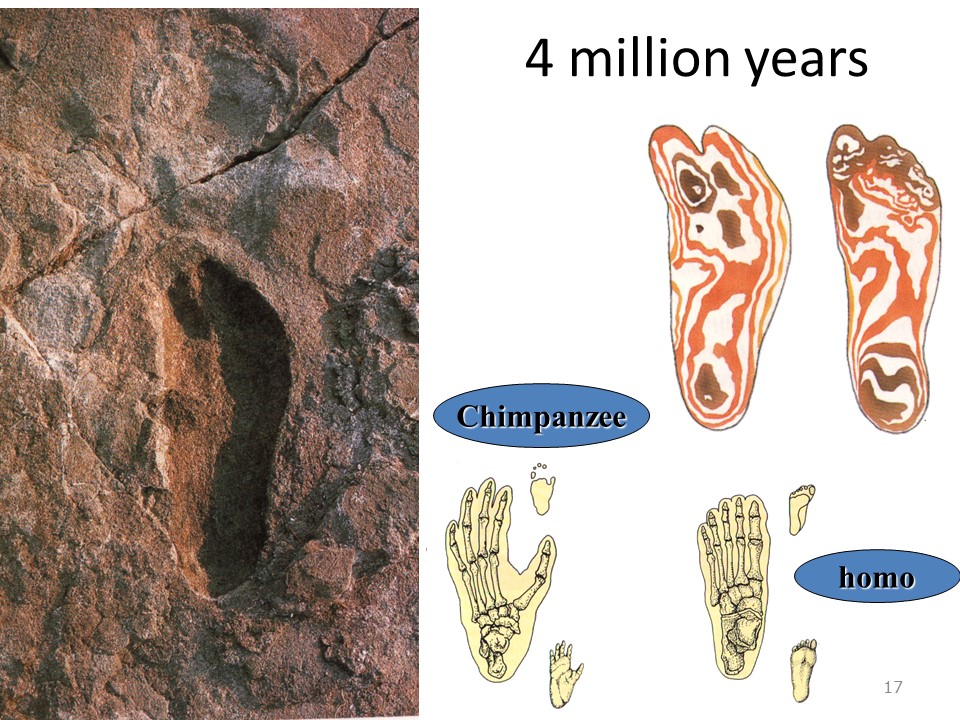 |
Footprints contain the main characteristics of the foot of homo sapiens: Realigning of the big toe towards the axis of the footIn addition to the transverse curvature visible in the chimpanzee, there is another longitudinal vault on the first ray.
|
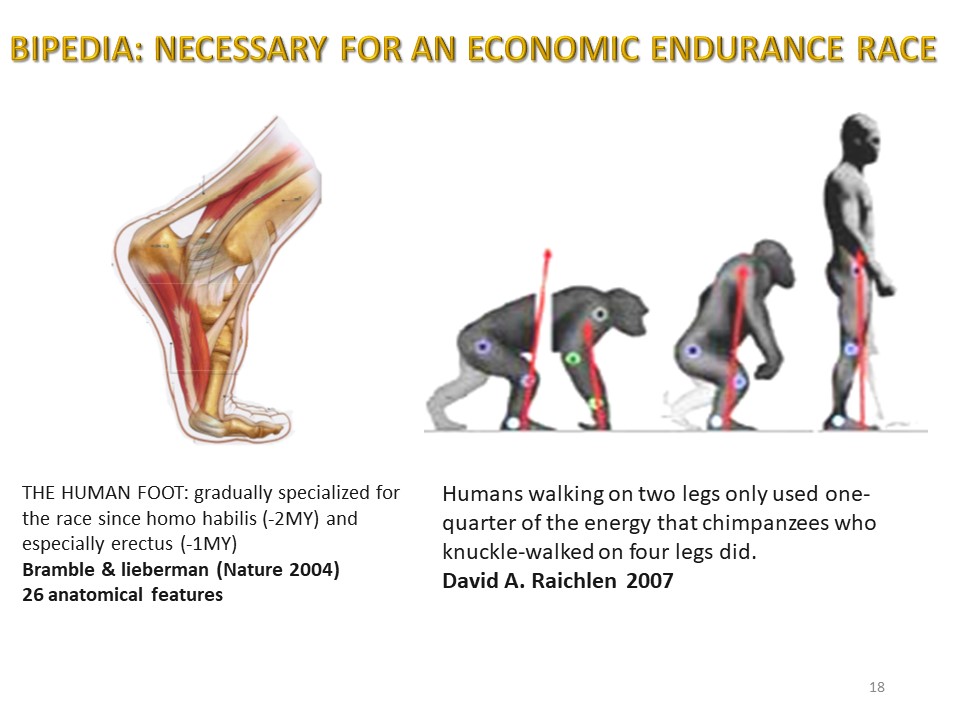 |
These modifications are essential for the race which is the characteristic of homo sapiens. THE HUMAN FOOT has gradually specialized for the race since homo habilis (2 million years ago) and especially erectus (1 million years ago)Human walking consumes a quarter of the energy used by chimpanzees to walk on all fours legs.
|
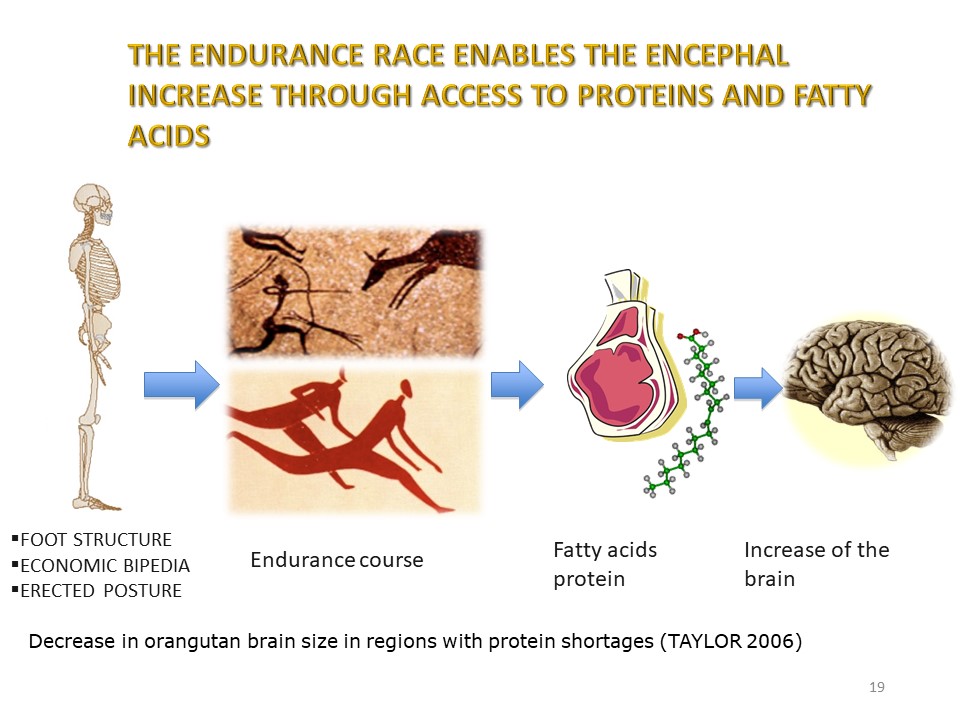 |
These are the protein fatty acids that are needed to increase the size of the brain. The great vegetarian apes could not grow their brain There is a decrease in orangutan brain size in regions with protein shortages (TAYLOR 2006) The endurance race allows: To reach carcasses before other scavengers (Bramble 2004). To flee a region poor in wildfowl. To reach areas rich in crustaceans and fish for fatty acids (Cunnane 2006). |
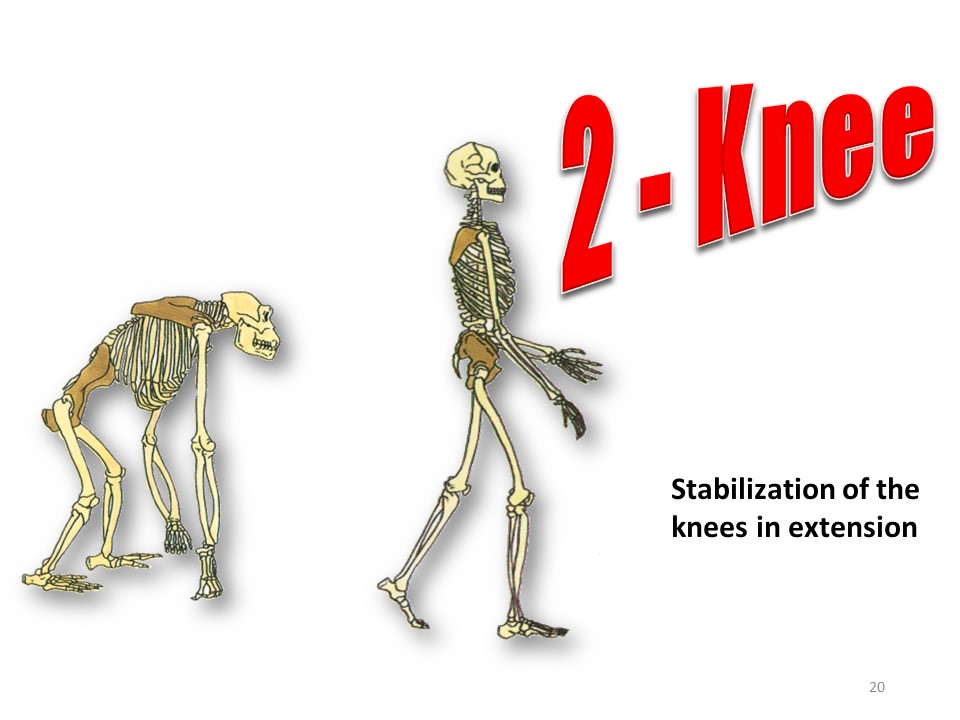 |
Knees will be stabilized in extension. |
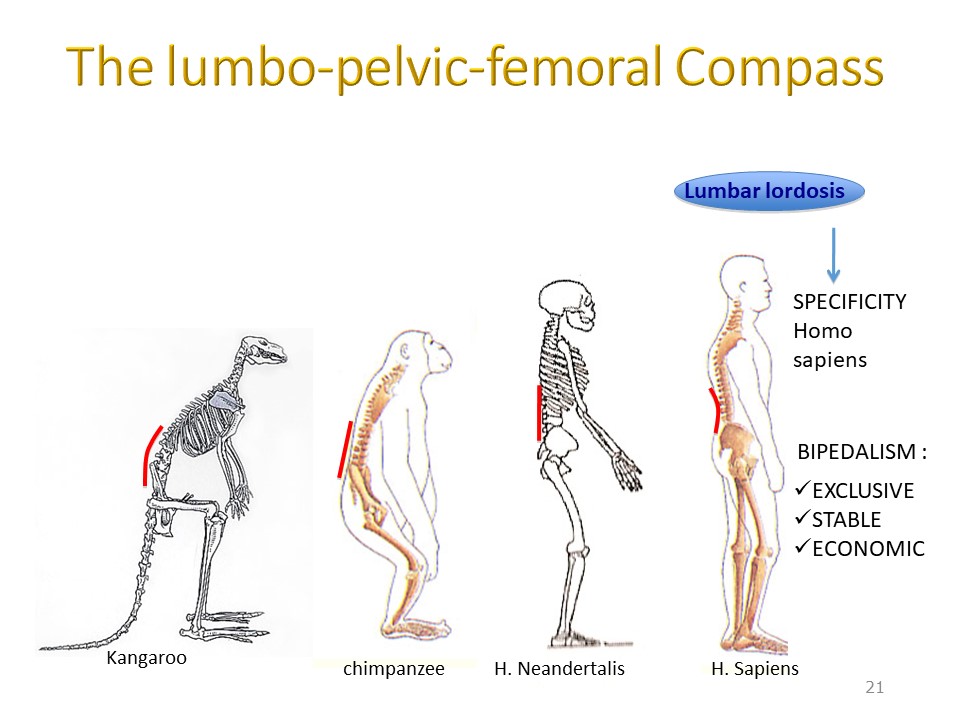 |
The progressive disappearance of the flexion of the lower limbs at the level of the knee allows the pelvis to be positioned in the sagittal plane. Saving energy when walking. |
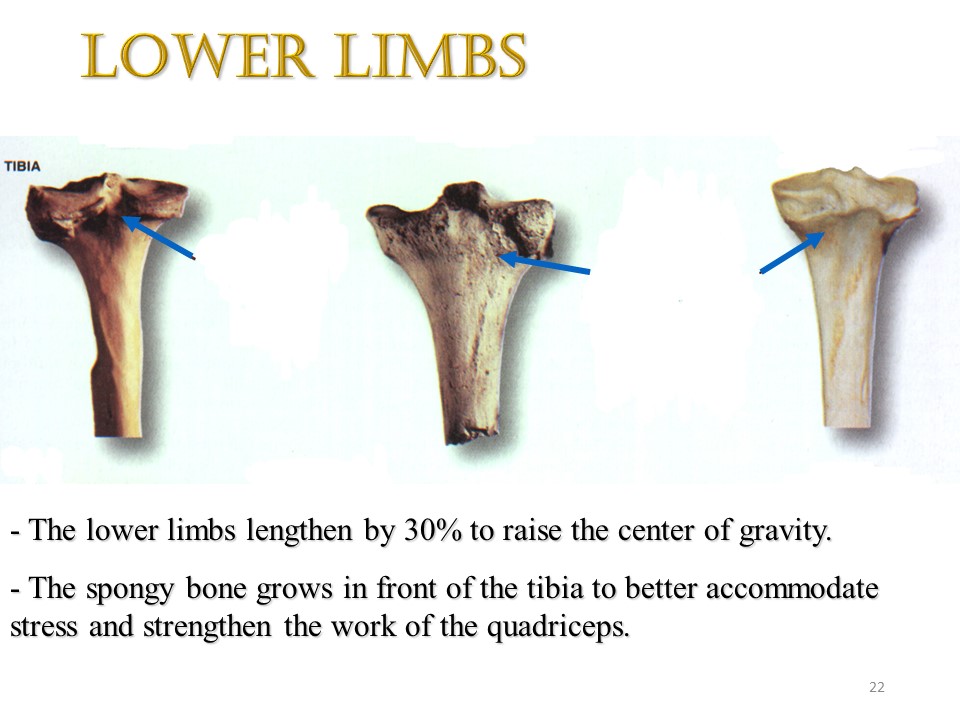 |
- The lower limbs lengthen by 30% to raise the center of gravity.
- The spongy bone grows in front of the tibia to better accommodate stress and strengthen the work of the quadriceps. |
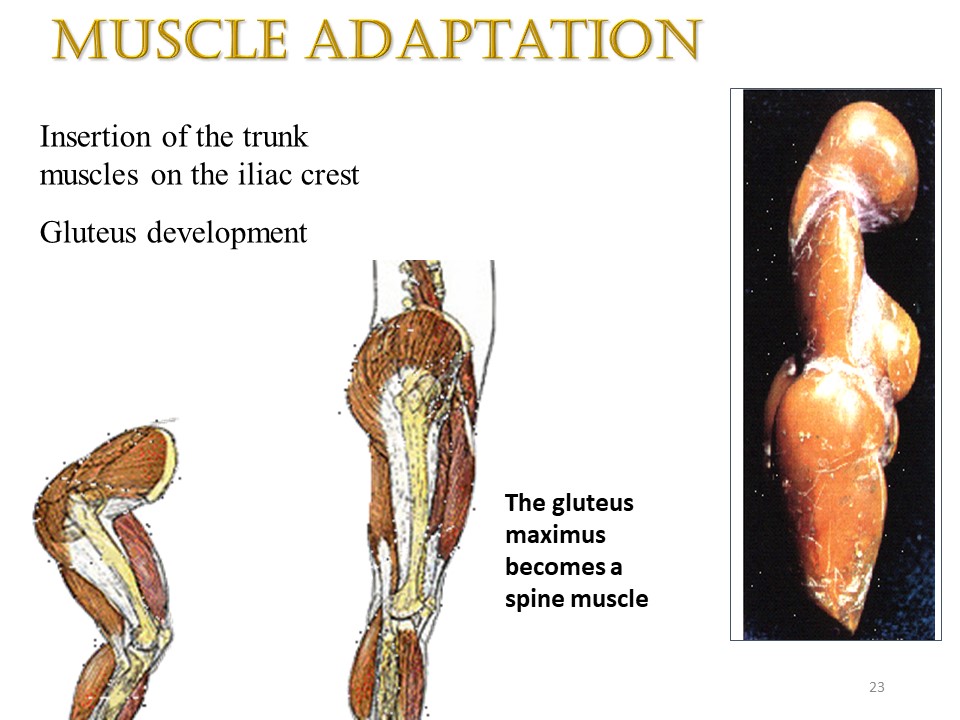 |
The development of the gluteal muscles allows the partial verticalization of the pelvis by inserting on the iliac crest. The gluteus maximus becomes a spinal muscle, The sculptors of Hottentot Venuses had noted the difference with great apes. |
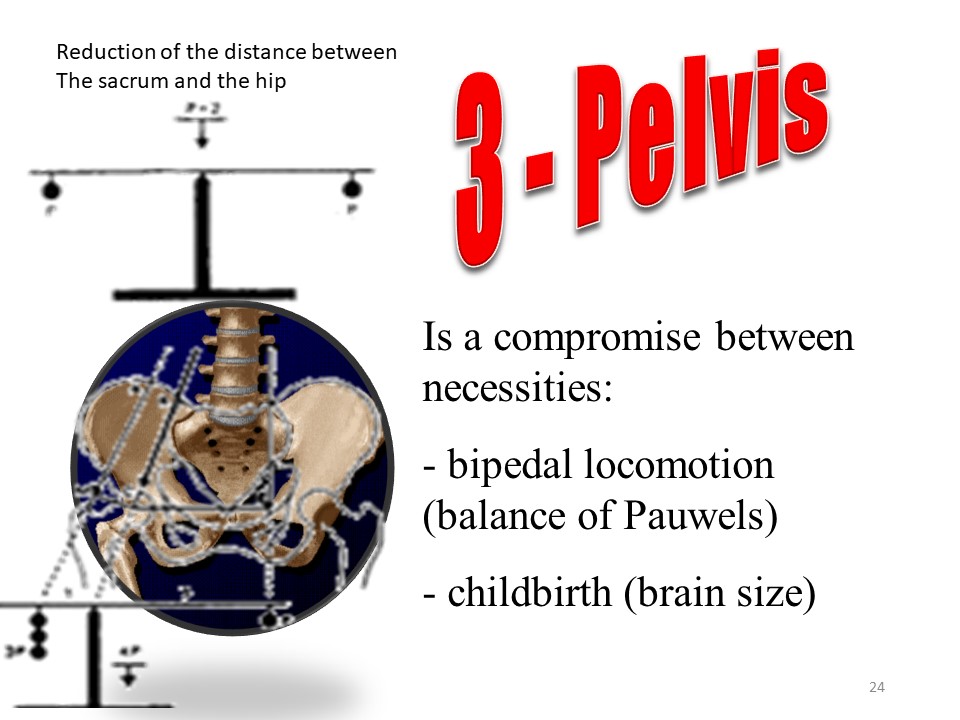 |
The pelvis is a compromise between the necessities of bipedal locomotion and childbirth conditioned by the size of the brain. Indeed, in one foot stand, it is the contracture of the gluteus medius which ensures the horizontality of the pelvis. |
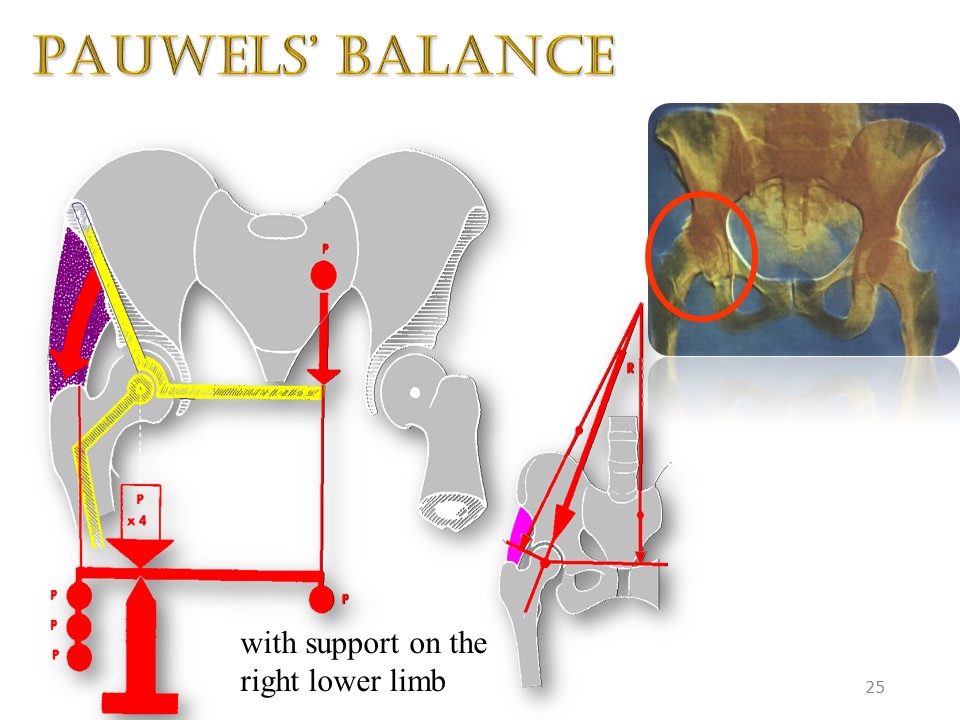 |
Therefore, the hip supports about 4 times the initial load, but this load will increase a lot if the articulation moves away from the line of gravity. Already, hip osteoarthritis is very common. |
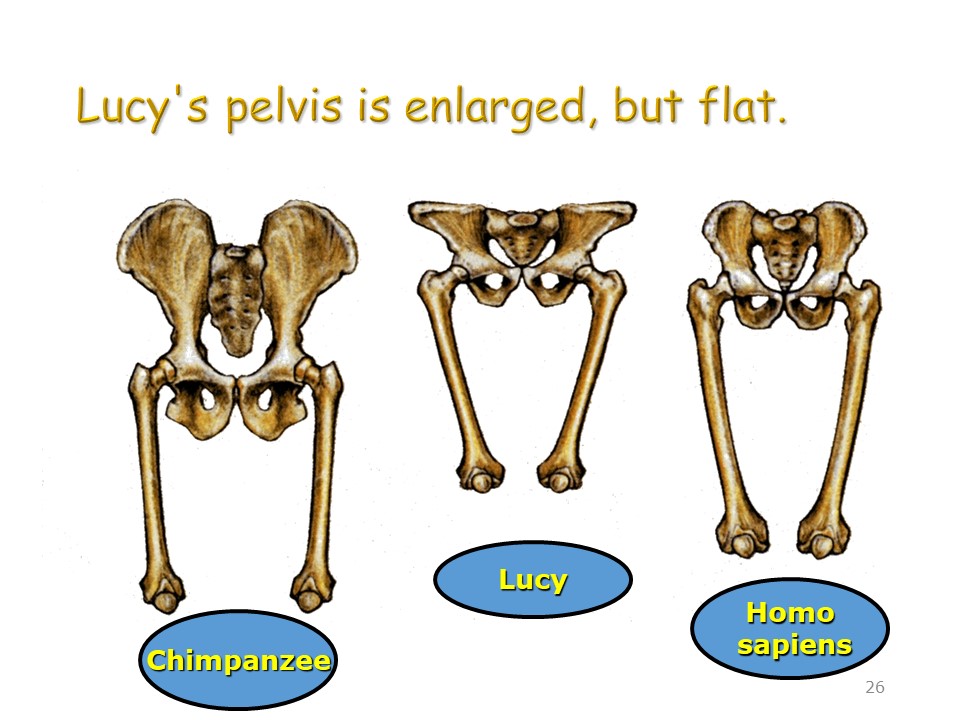 |
Lucy's pelvis is wider, but not deep enough. It is only among homo sapiens that sphericity will be maximum. If we compare man with ape, the pregnancy that is 8 months in the great apes should be 27 months in humans, which would totally disproportionate the pelvis and make it unfit for locomotion. It follows a very important immaturity at birth and the need for social cohesion to protect the child. |
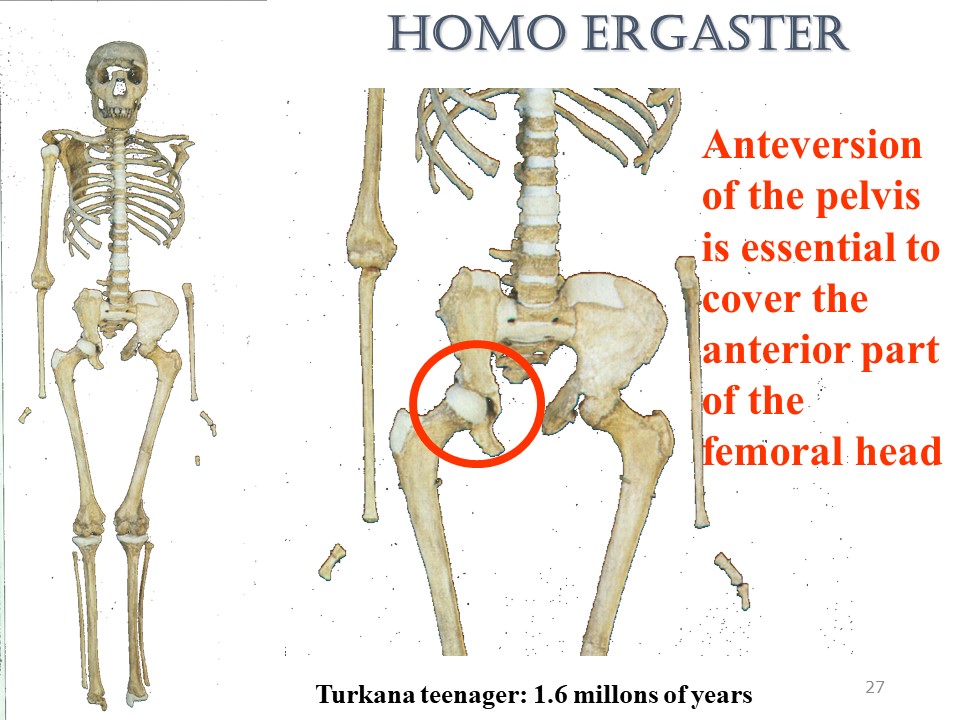 |
One of the consequences of pelvic verticalization is the lack of coverage of the anterior part of the femoral heads. It is the pelvic anteversion that compensates and improves the femoral head coverage. Pelvic anteversion also allows lumbar lordosis. |
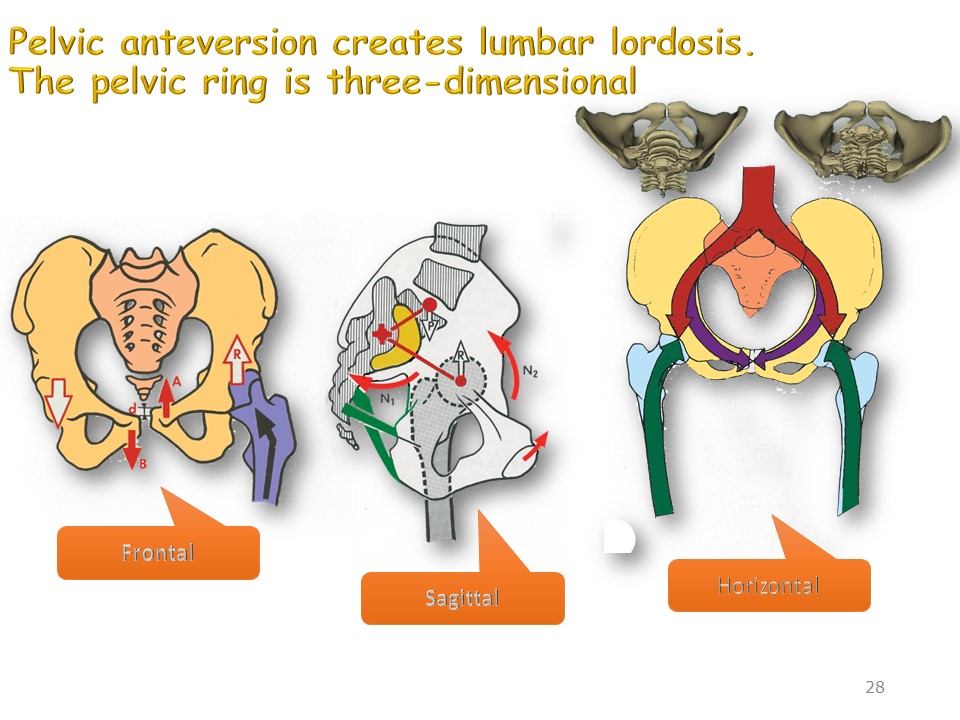 |
The pelvic ring is balanced in the 3 dimensions of space. We have already mentioned the Pauwel’s balance in the frontal plane. In the sagittal plane, the pelvic version is balanced with lumbar lordosis. We will see that the morphostatic of the spine in the sagittal plane depends on the lumbo-pelvic incidence. In the horizontal plane, the pelvic step is a rotation of the pelvis alternately to the left and to the right, which allows an optimal distribution of the load on the femoral head. |
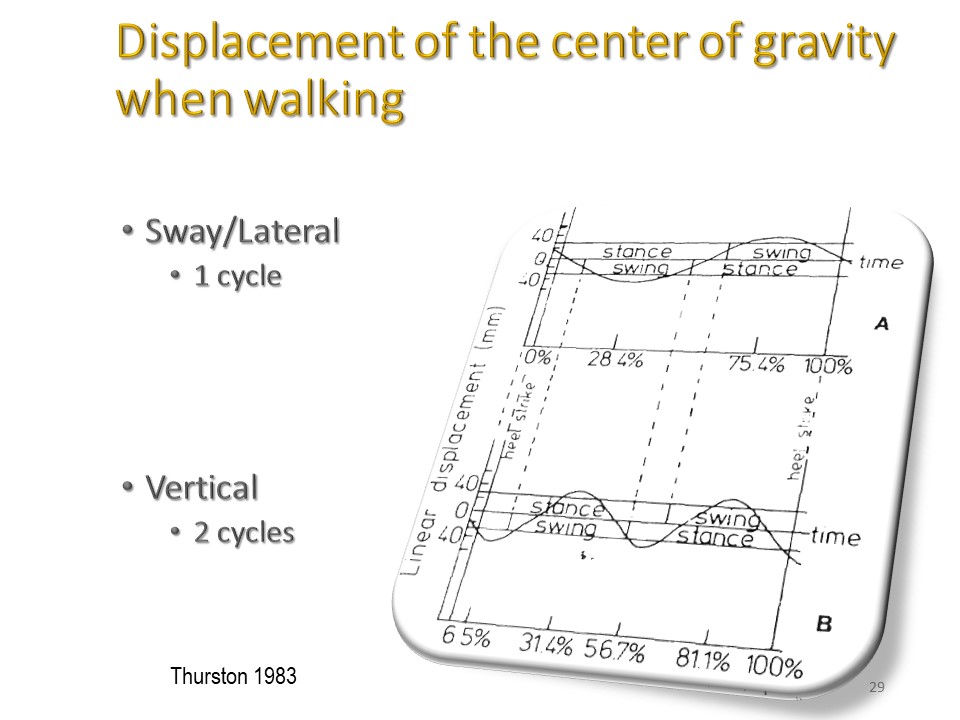 |
Two vertical cycles to one lateral one. Peaks for vertical for the mid-stance phase of each leg and valleys at heel strike Peaks for lateral at mid-stance of each leg as weight is shifted from one leg to the other. |
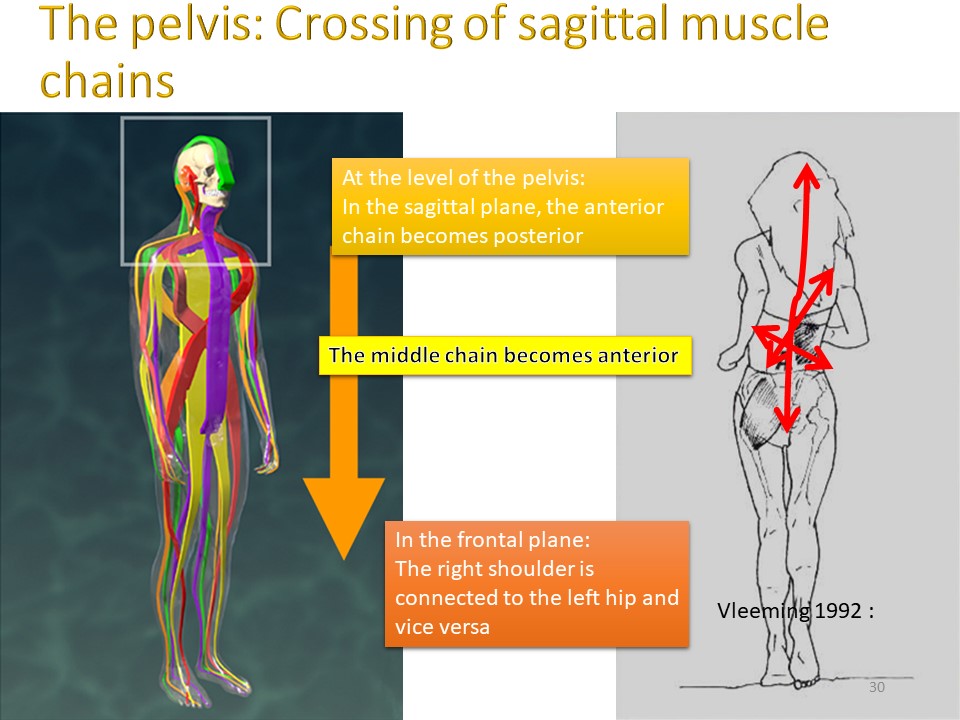 |
It is at the level of the pelvis that the front chain in purple crosses to pass under the middle chain in yellow then behind the rear chain in green at the knee. |
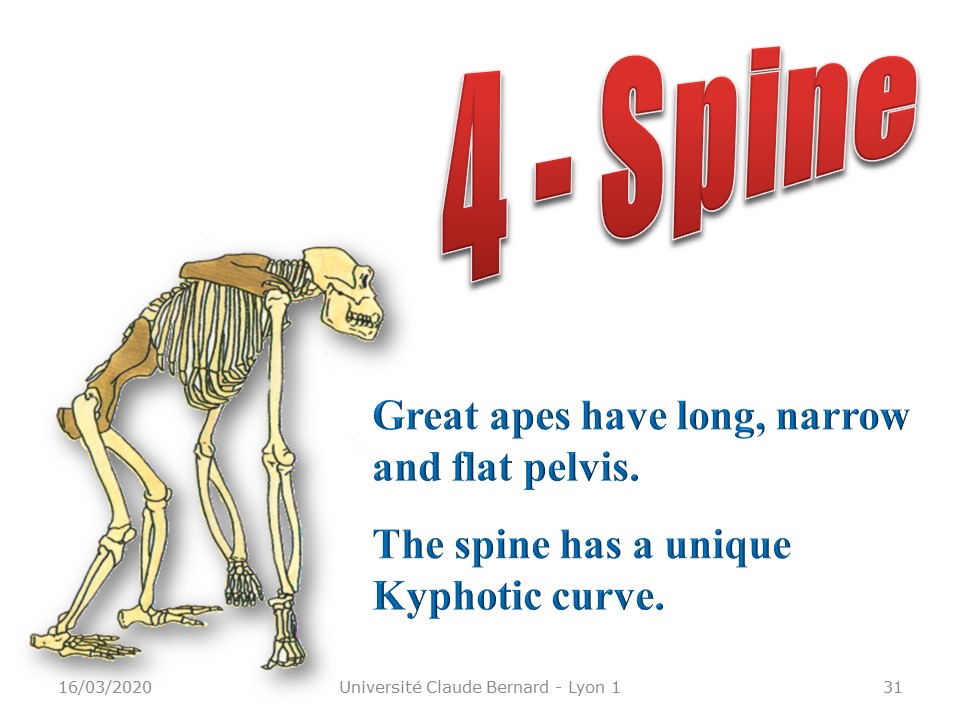 |
We have seen that great apes have long, narrow and flat pelvis. The spine has a unique Kyphotic curve. |
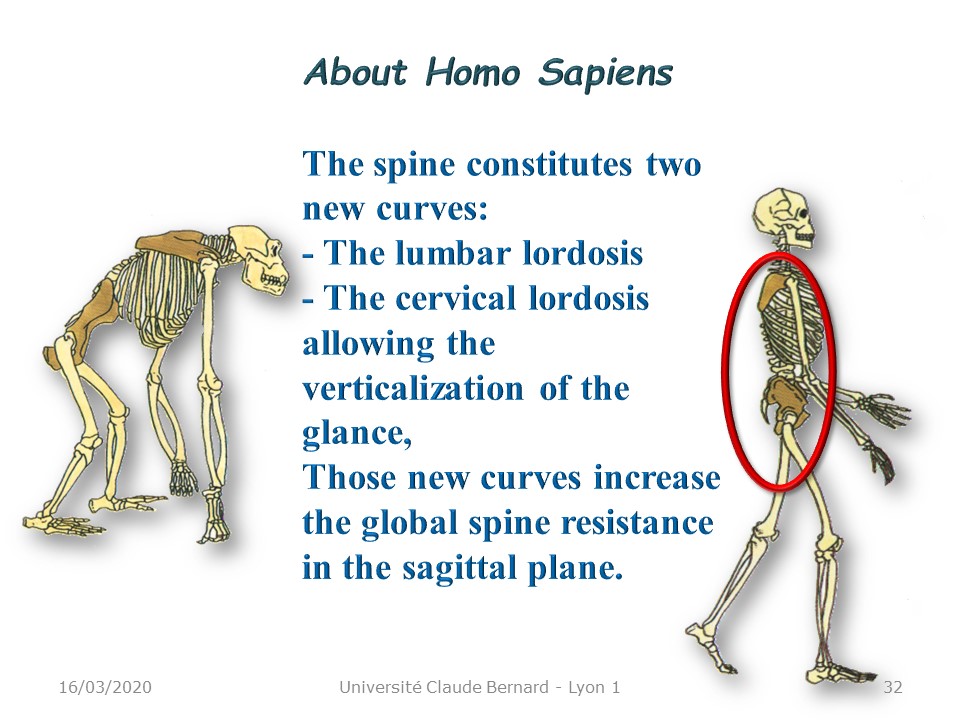 |
The spine constitutes two new curves: The lumbar lordosis and The cervical lordosis allowing the verticalization of the glance, Those new curves increase the global spine resistance in the sagittal plane. |
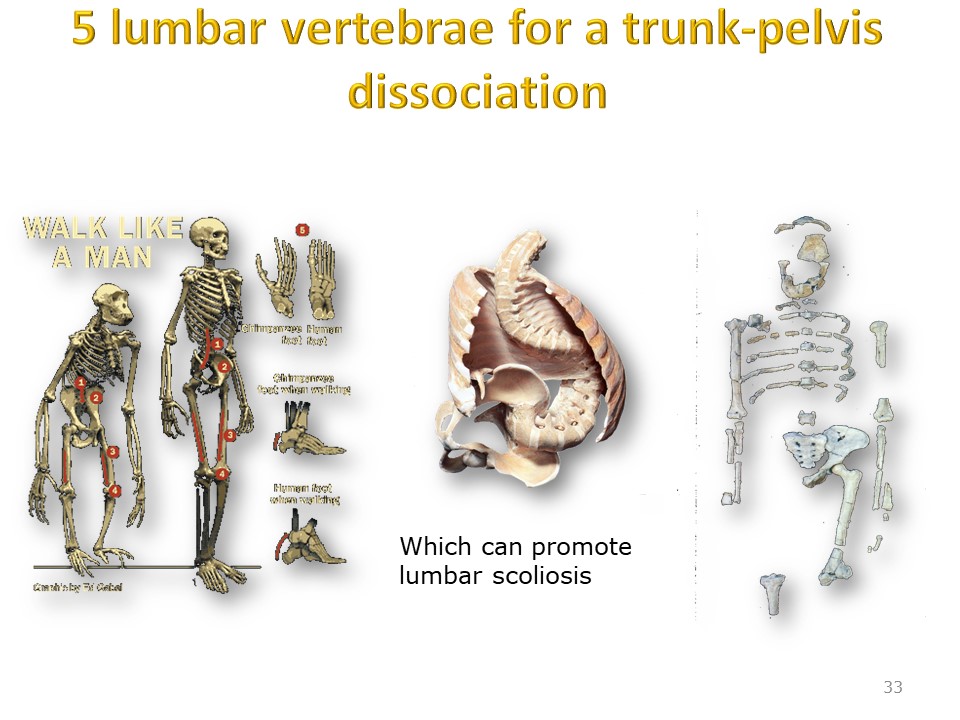 |
We have seen that the 5 lumbar vertebrae allow dissociation of the trunk on the pelvis with the pelvic step during walking and running, |
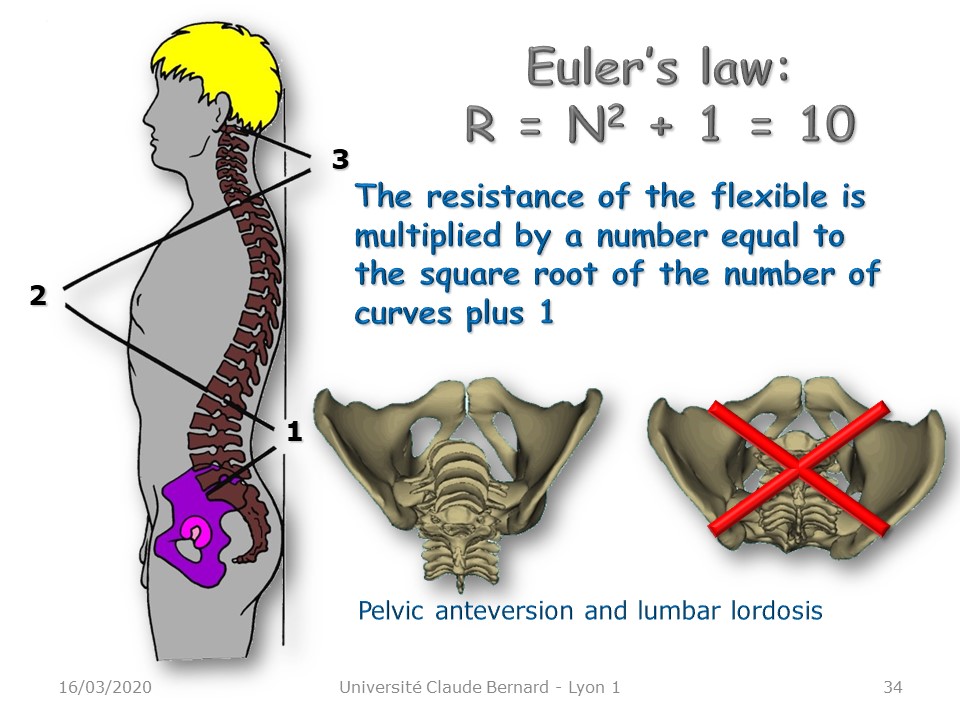 |
The resistance of the spinal flexible is multiplied by a number equal to the square root of the number of curves plus 1 |
 |
This resistance allows a decreasing of the paravertebral muscle structure, which corresponds to a decrease of the transversal and spinous apophysis of the posterior arch. |
 |
.
|
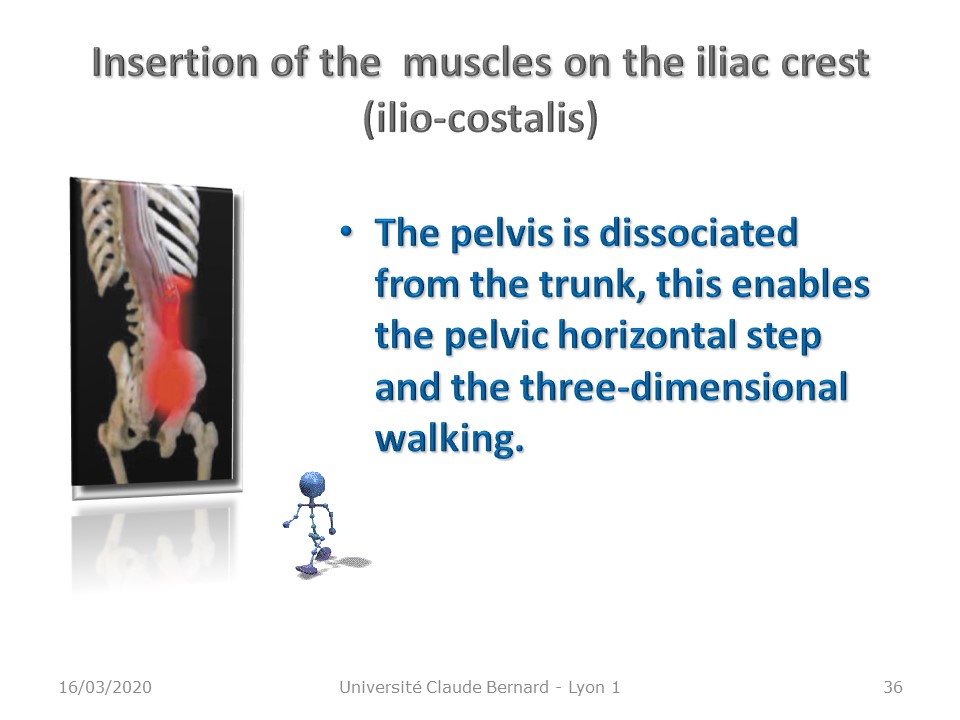 |
The dissociation of the pelvic and scapular belts leads to a modification of the insertion of the ilio-costal muscles moving on the iliac crest. Those modifications enable the pelvic horizontal step and the 3 dimensions of the walking. . |
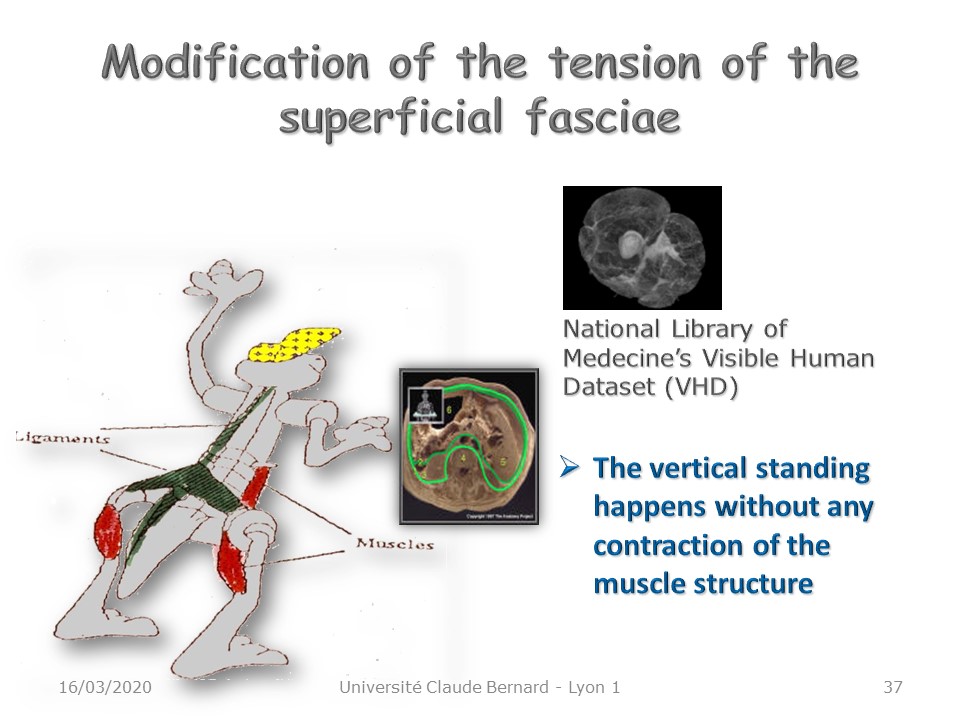 |
We note, since the Rhesus monkey, a transformation of some muscle into ligaments especially at the cervical and lumbo-pelvic level. The tension of the superficial fasciae enables a vertical standing without any active contraction of the muscle structure. |
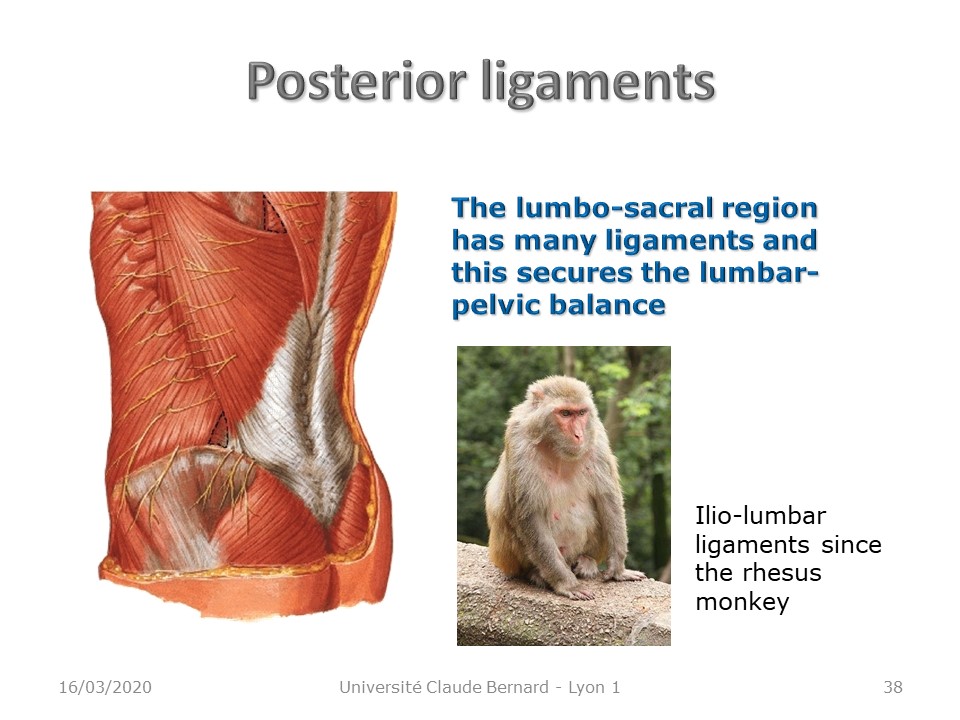 |
The lumbo-sacral region has many ligaments and this secures the lumbo-pelvic balance and stability. |
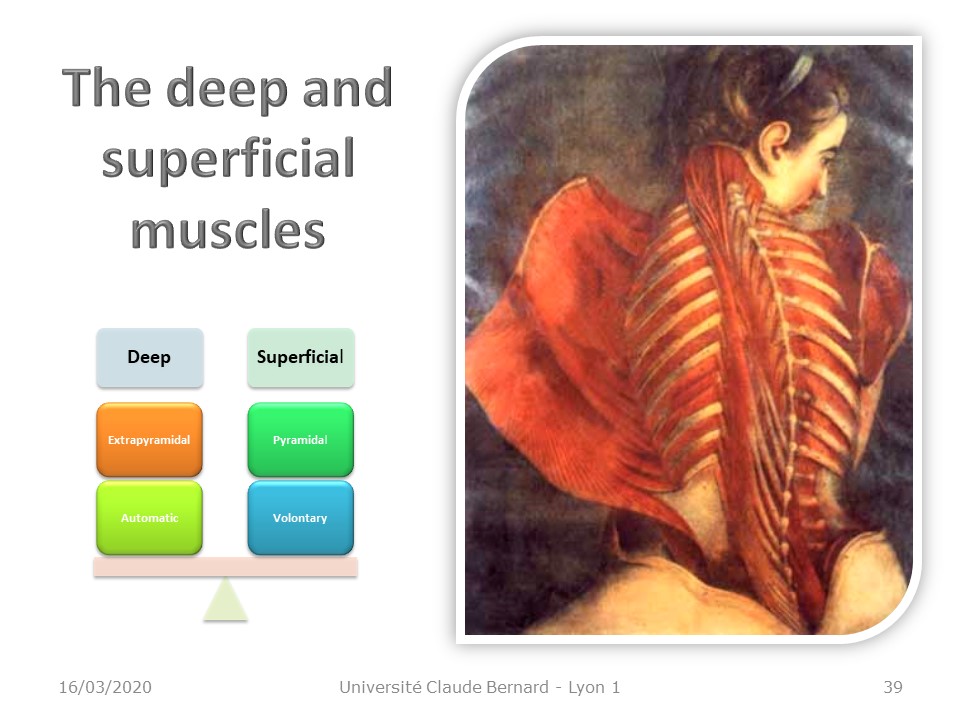 |
The deep muscles of the gutters between the spinous and the transverse process depend on the automatic extrapyramidal system, whereas the superficial muscles are pyramidal. . |
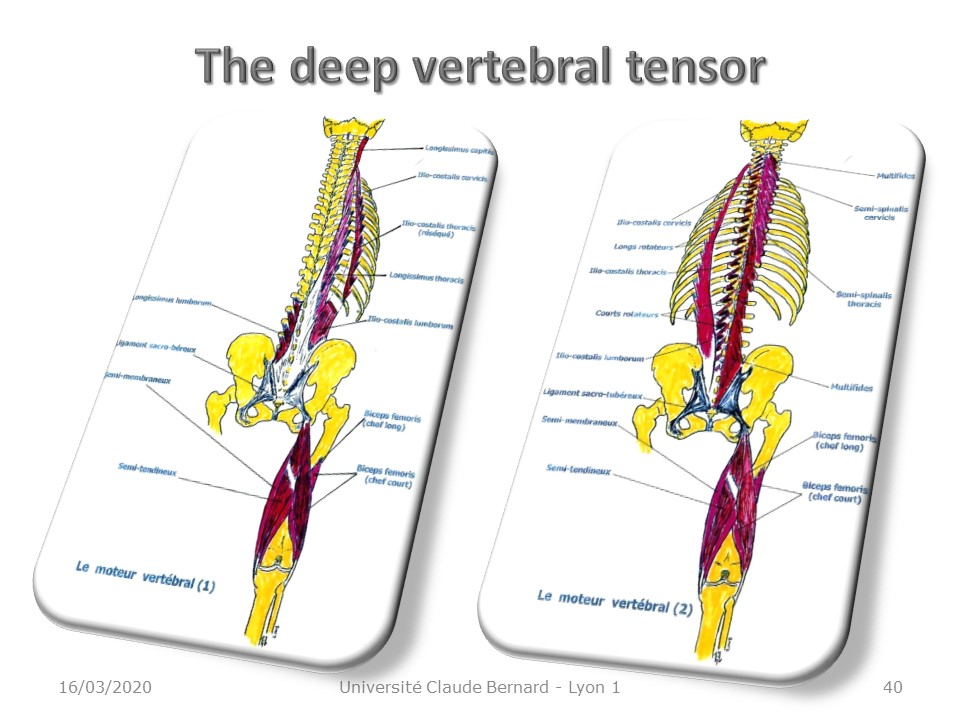 |
The deep paravertebral muscles are in continuity with the hamstrings thanks to the Sacro-iliac joint and ligaments. |
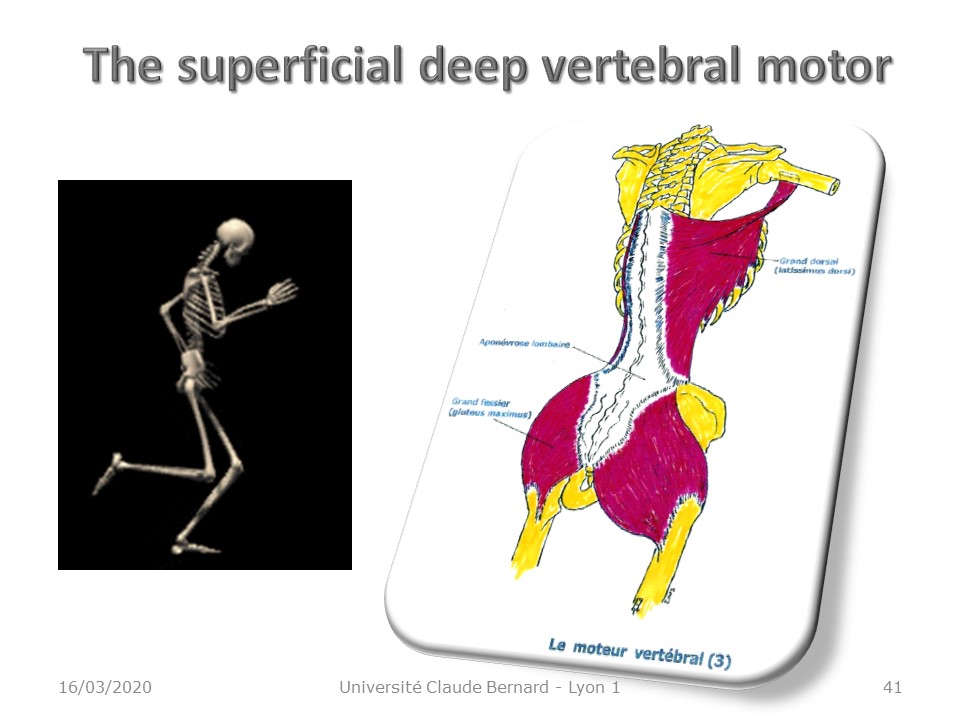 |
Concerning the superficial muscle structure, it is the superficial fascia which assures the continuity with a posterior femoral insertion and an anterior humerus bone insertion. This explains the opposite movement of the upper and lower limbs in a sagittal plane. .
|
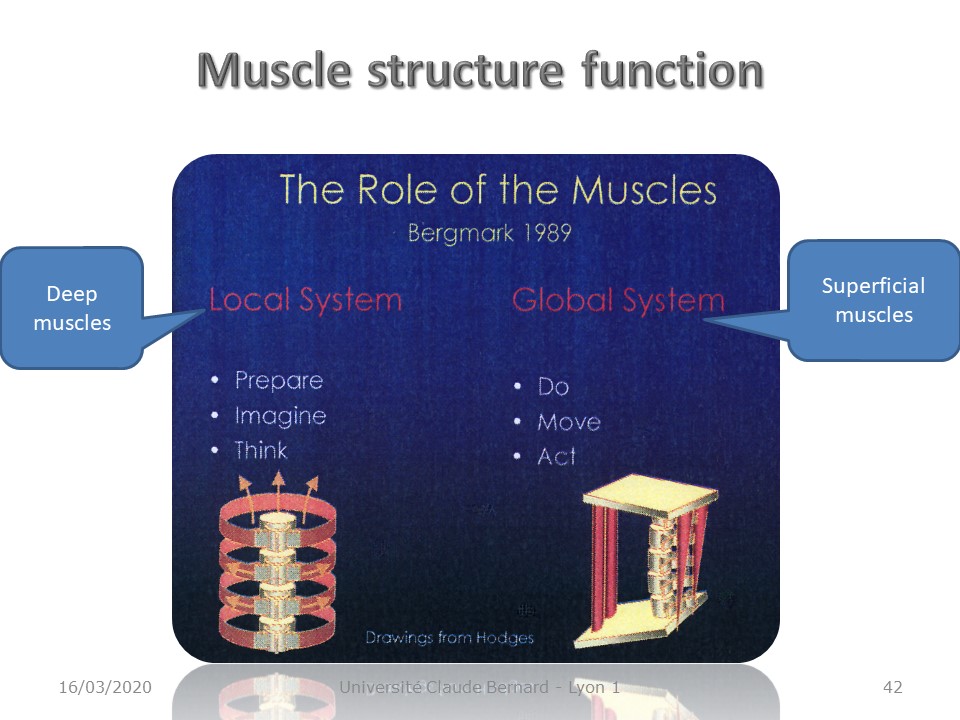 |
The role of the paravertebral muscles was clarified by Bergman in 1989. The deep local muscles are tensioning the spine before movement. These are the muscles of thought and imagination. The overall superficial muscle structure will make movement on a spine stabilized by the deep muscles. These are the muscles of movement and action.
|
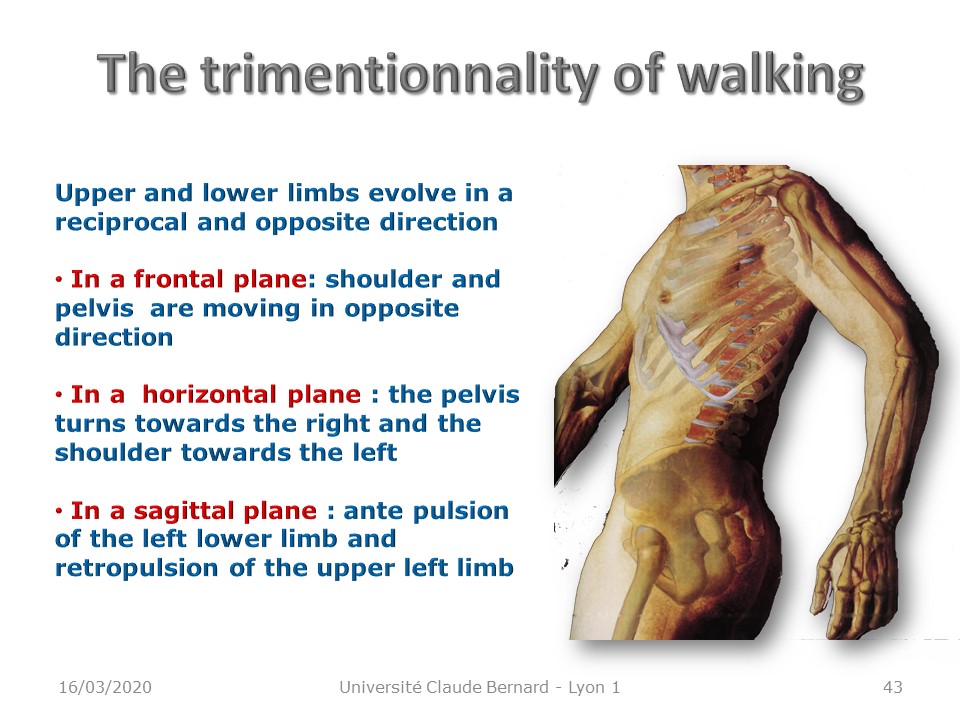 |
Upper and lower limbs evolve in a reciprocal and opposite direction. In a frontal plane: shoulder and pelvis are moving in opposite direction. In a horizontal plane: the pelvis turns towards the right and the shoulder towards the left. In a sagittal plane: ante pulsion of the left lower limb and retropulsion of the upper left limb.
|
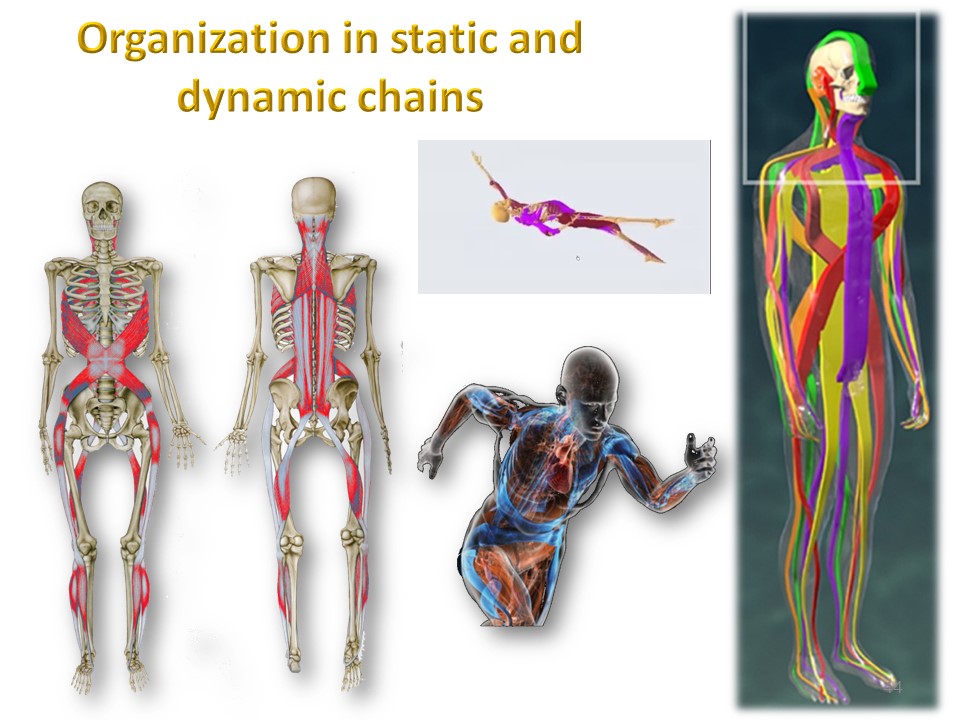 |
Fasciae and muscles are organized into chains from skull to foot. The spine is the fundamental axis. Depending on the movement, the strings will be solicited in the different planes of the space. The pyramidal system works on a pretension managed by the extrapyramidal system. For scoliosis, the spiral chains must be reinforced by an activity in dissociation of the girdles.
|
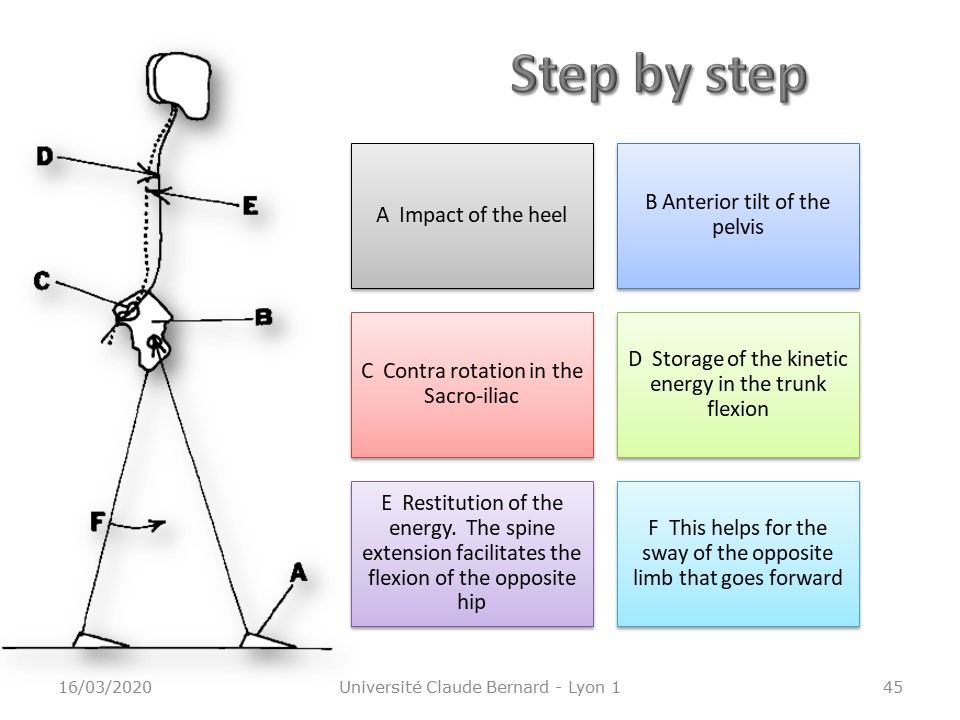 |
Walking can be divided into six steps: Impact of the heel, Anterior tilt of the pelvis, Contra rotation in the Sacro-iliac joint, Storage of the kinetic energy in the trunk flexion, Restitution of the energy. The spine extension facilitates the flexion of the opposite hip, which is useful for the sway of the opposite limb that goes forward.
|
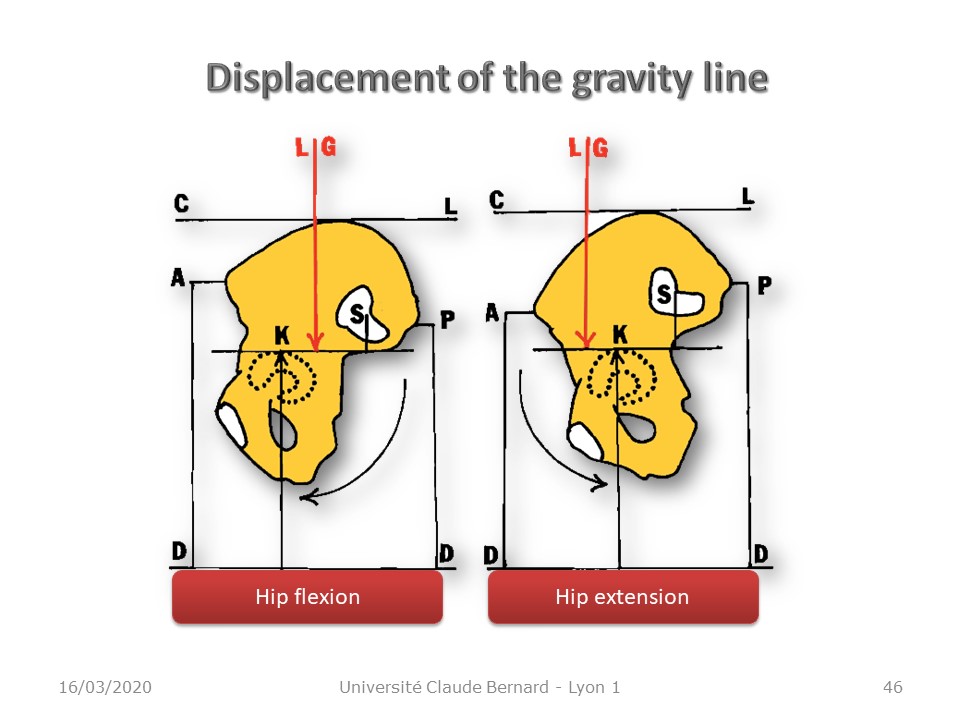 |
The gravity line oscillates on both sides of the femoral head. From anterior in hip flexion, it becomes posterior in extension.
|
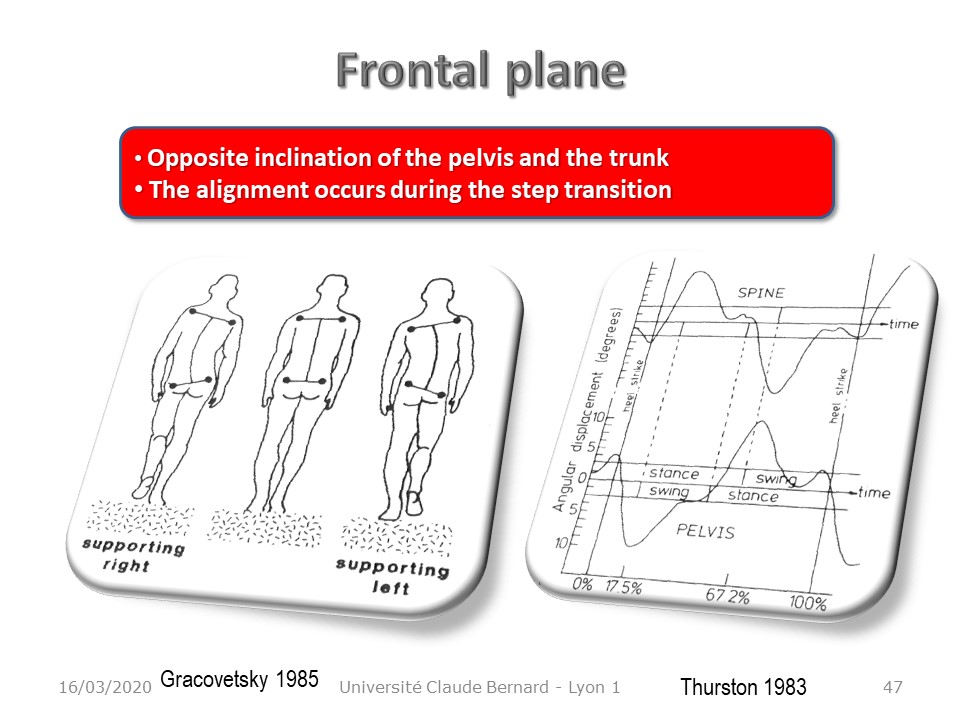 |
In the frontal plane the pelvis and the trunk are bending in Opposite inclination. The alignment occurs during the step transition.
|
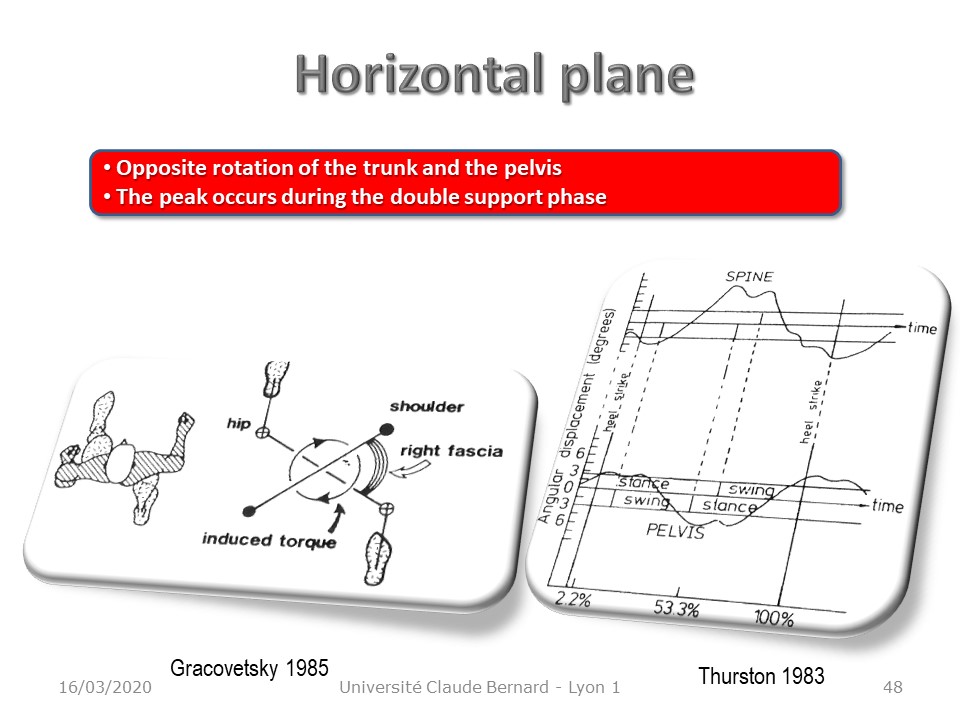 |
In the horizontal plane, trunk and pelvis are also rotating in opposite directions. The peak occurs during the double support phase,
|
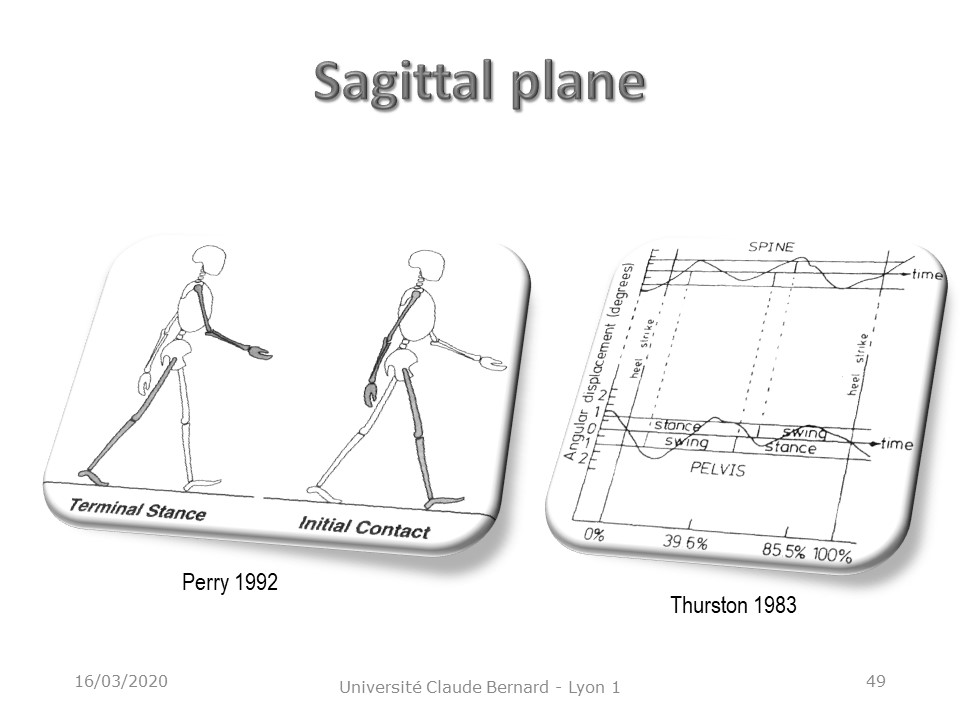 |
In the sagittal plane, there are 2 cycles of angular displacement.
|
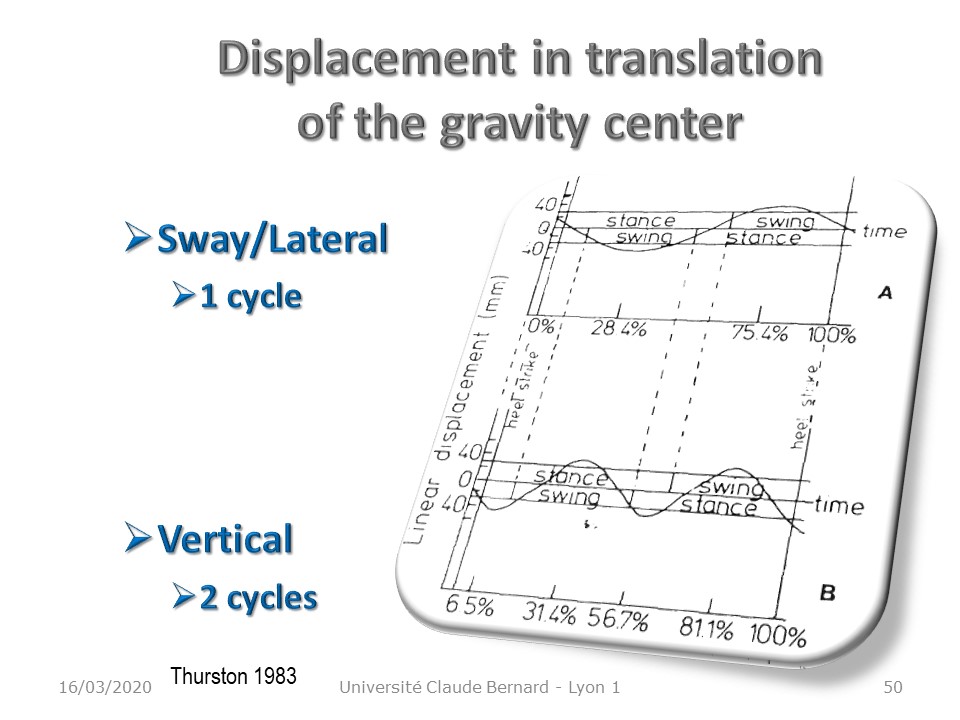 |
This is the same for the linear displacement of the center of gravity with a lateral cycle and two vertical cycles.
|
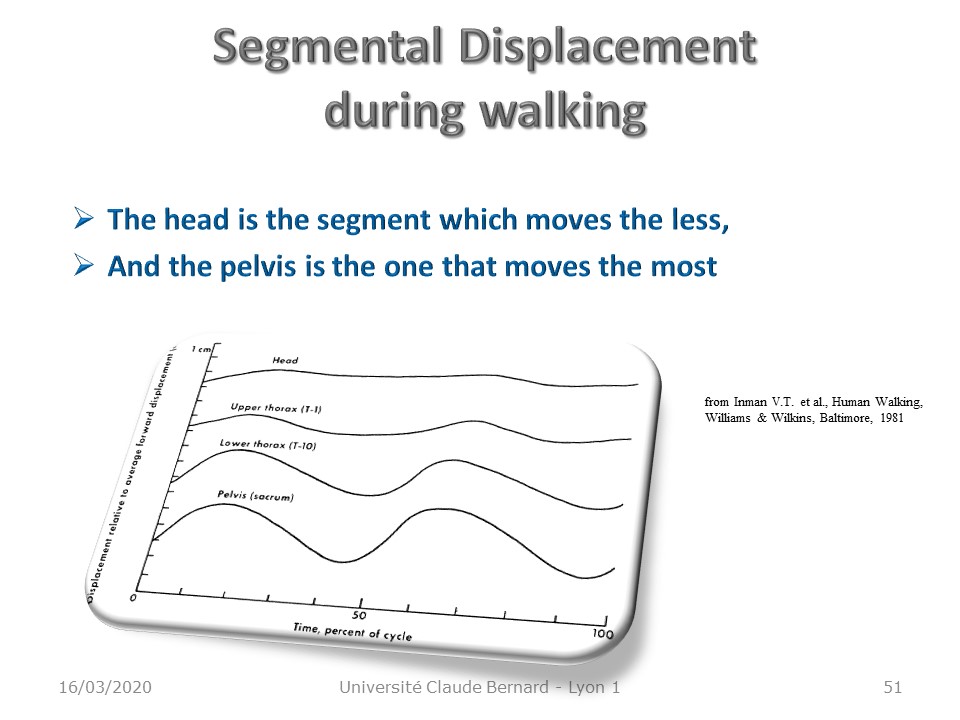  |
The amplitude of the displacement varies. It is maximal at the pelvis level and minimal at the level of the head.
|
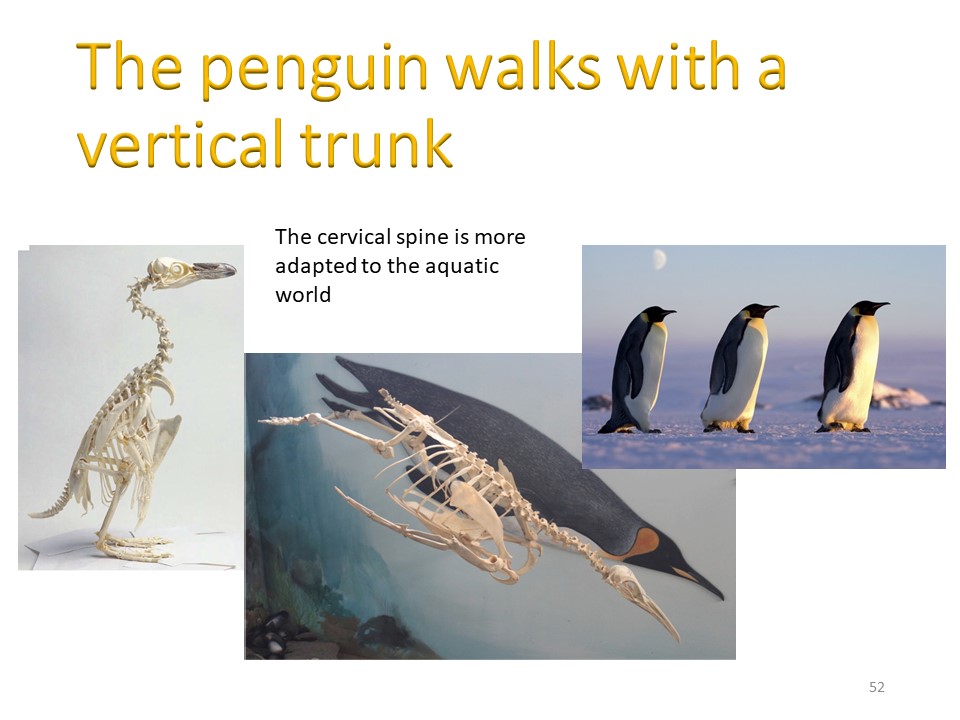 |
The penguin is the vernacular name for seabirds in the southern hemisphere. It is 70 million years old and has a vertical trunk. The wings do not allow it to fly, but constitute an excellent fin. The cervical spine has more than 10 cervical vertebrae and is more adapted to the aquatic world than to the terrestrial world..
|
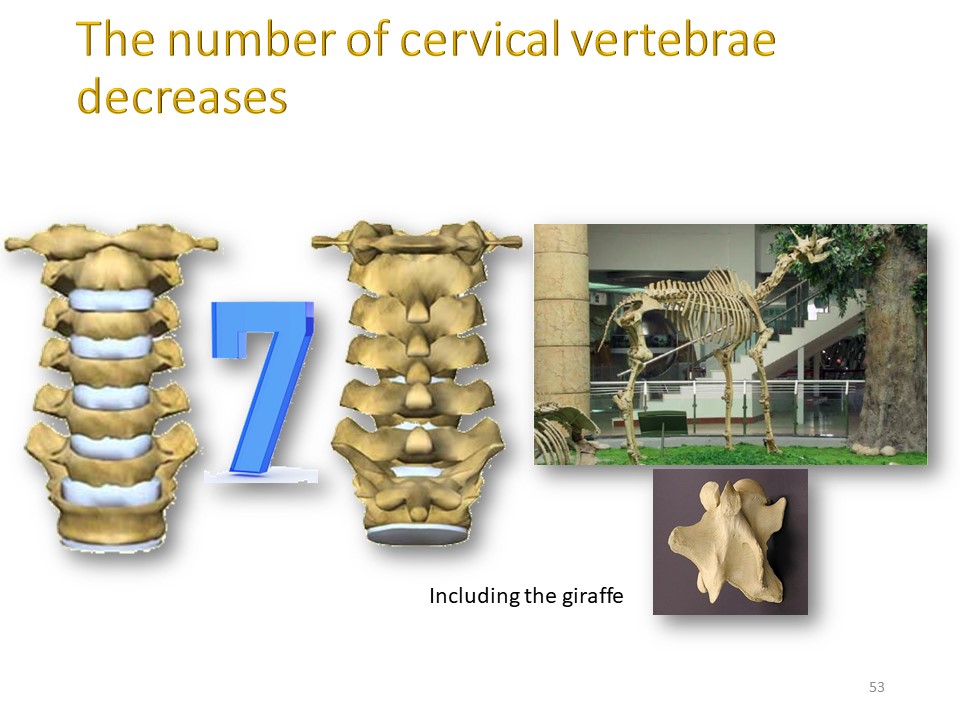 |
On the other hand in mammals the cervical vertebrae are almost always 7 in number, including in the giraffe.
|
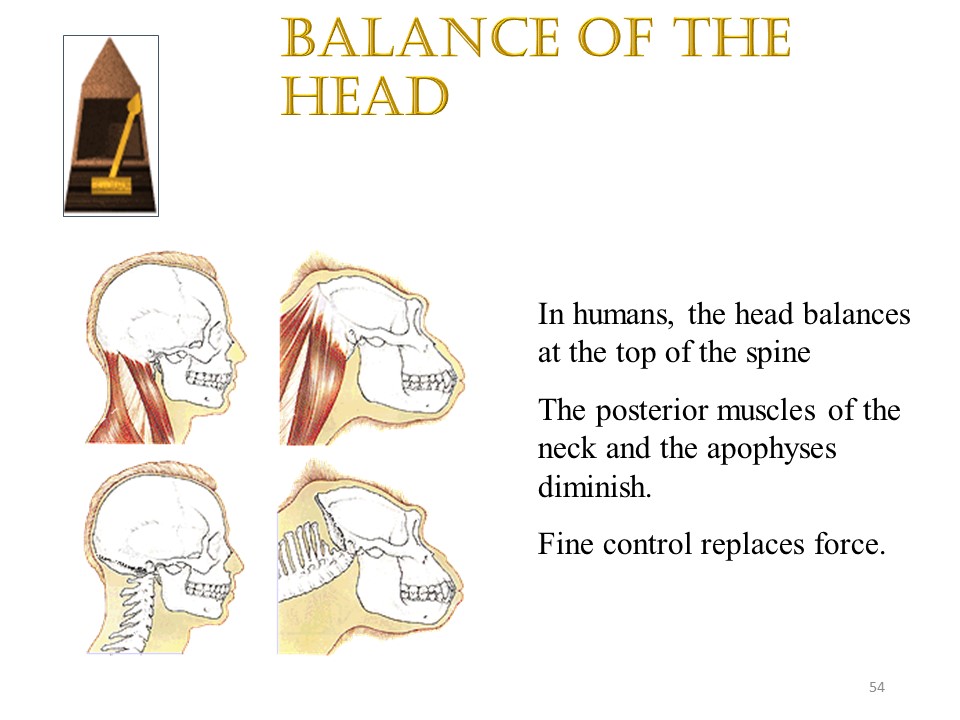 |
The balance of the head is very different in the chimpanzee and in the homo sapiens. In humans, the head balances at the top of the spine, the tension of the posterior muscles decreases, and the spinous and transverse processes are less bulky. Fine muscle control (a nerve fiber for a muscle fiber) replaces strength.
|
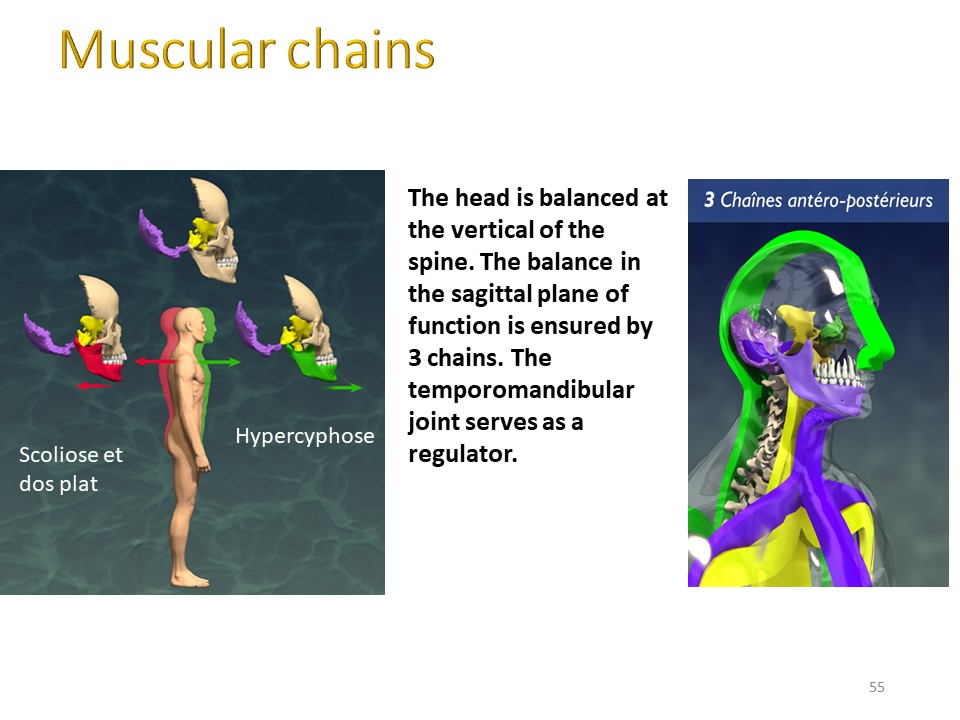 |
|
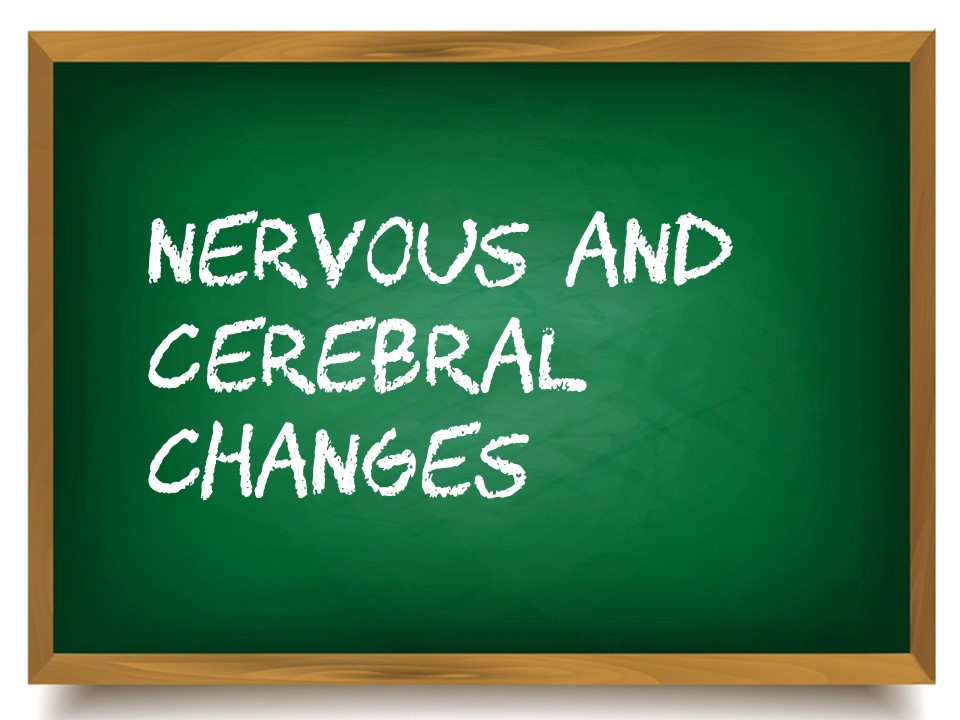 |
.
|
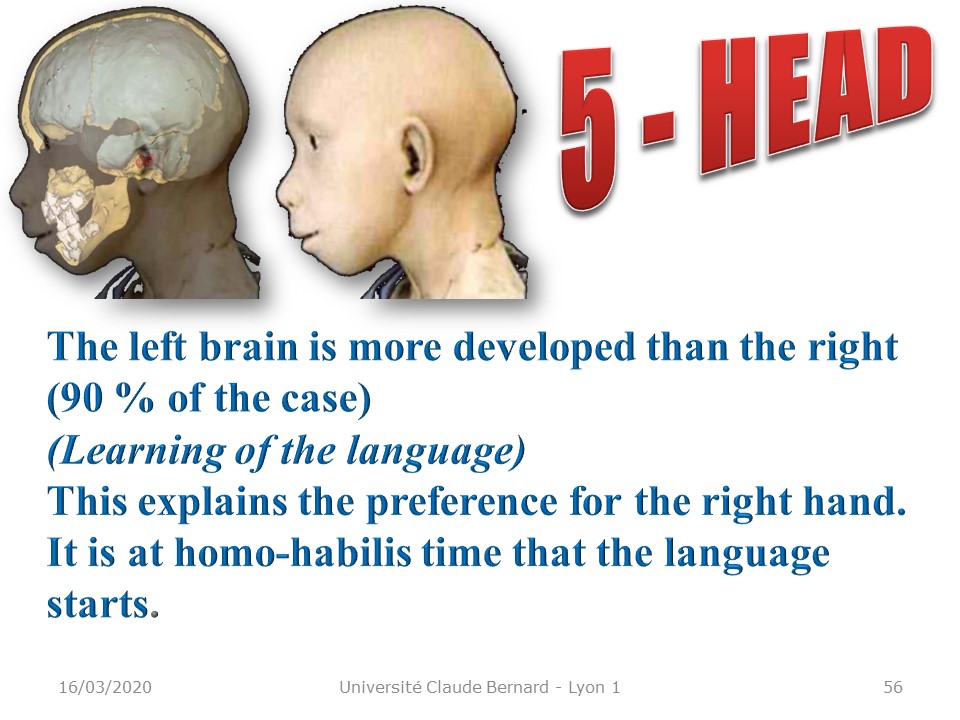 |
The child is able to differenciate is right hand from his left hand at around 7 rears old. At the same age he is going to be able to run and start dexterity sport thanks to the acquisition of a usefull balanced system
|
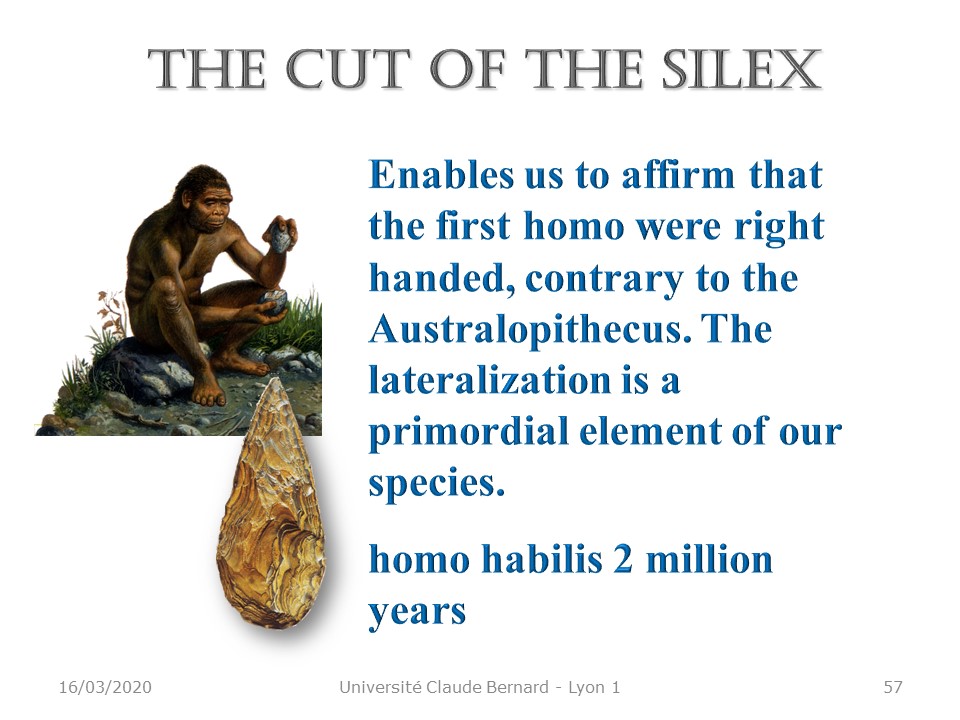 |
|
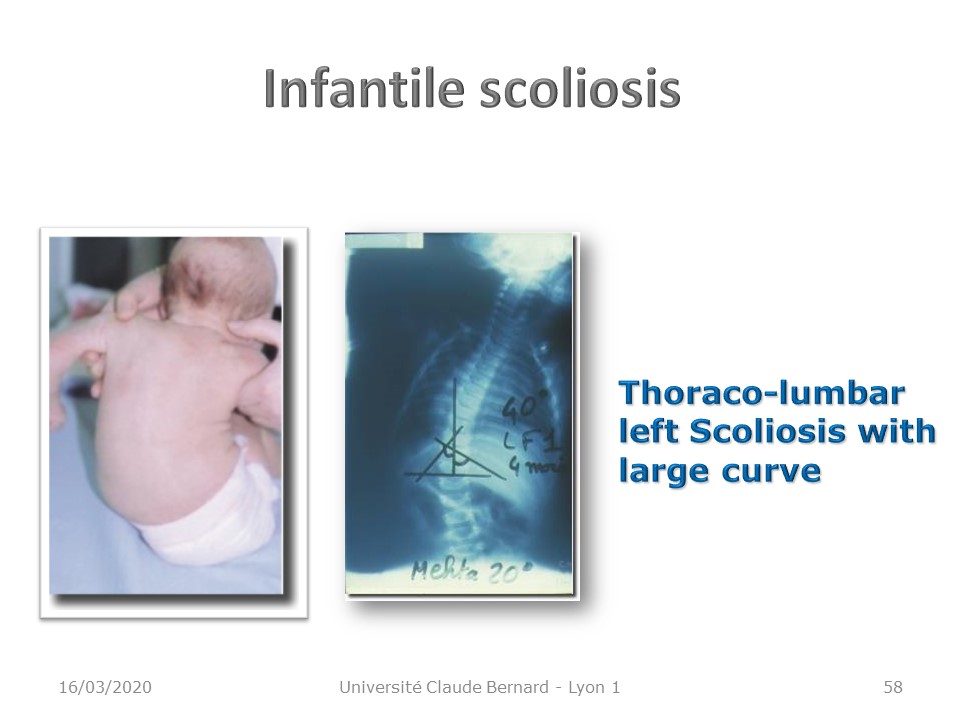 |
The infantile scoliosis is lateralized 50% are on the left and 50% on the right
|
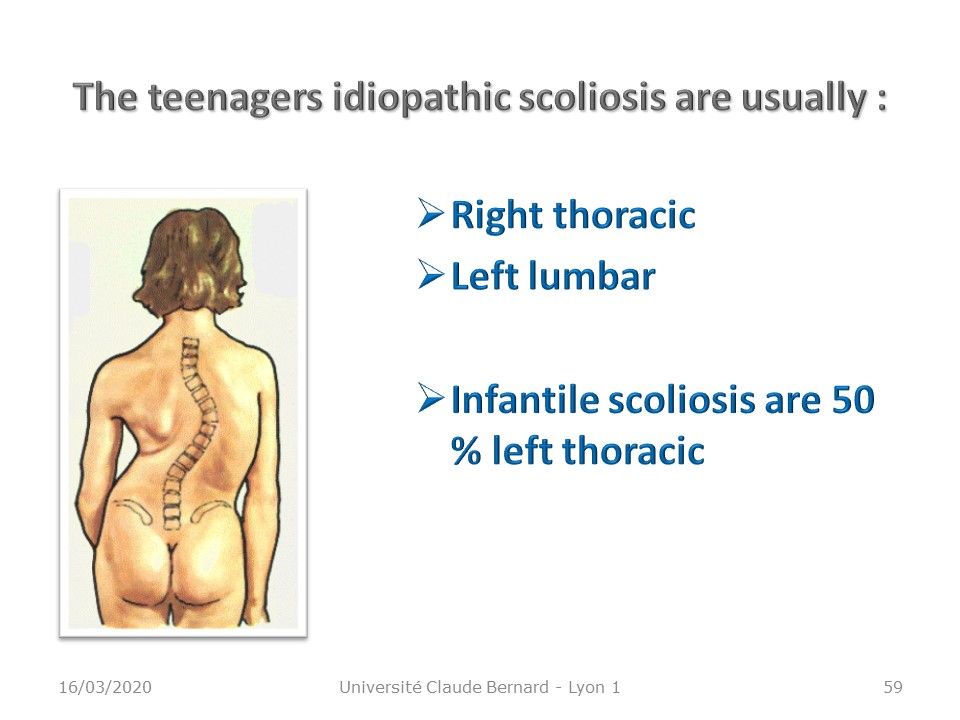 |
|
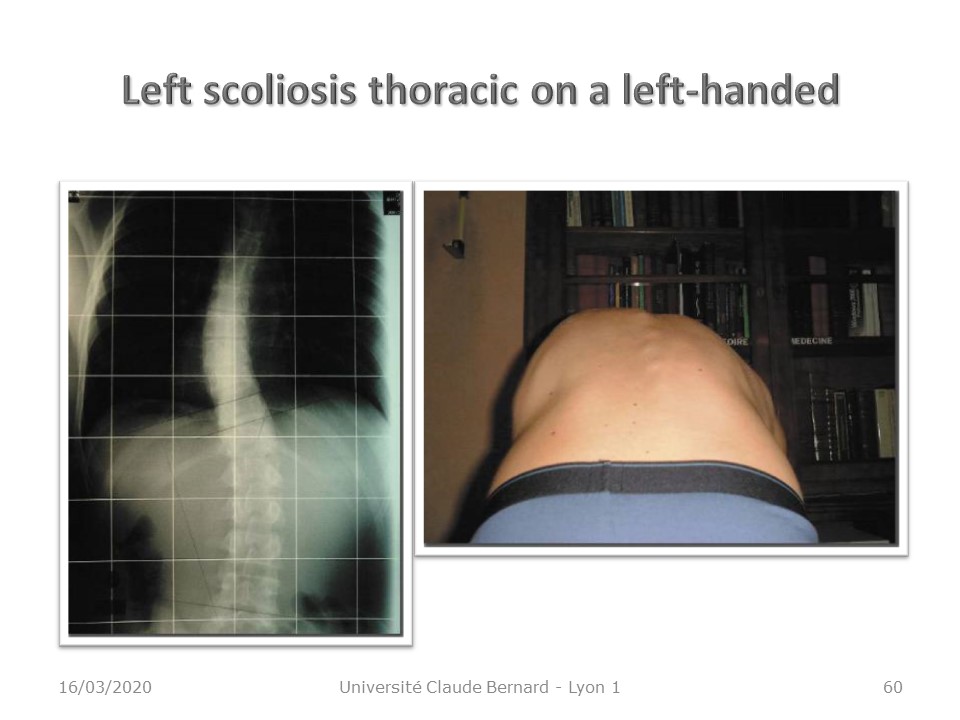 |
Left handed often have left thoracic scoliosis. |
 |
The posterior occipital hole moves towards the front, as we can see comparing a chimpanzee and the skull of the oldest men, Tournaï. |
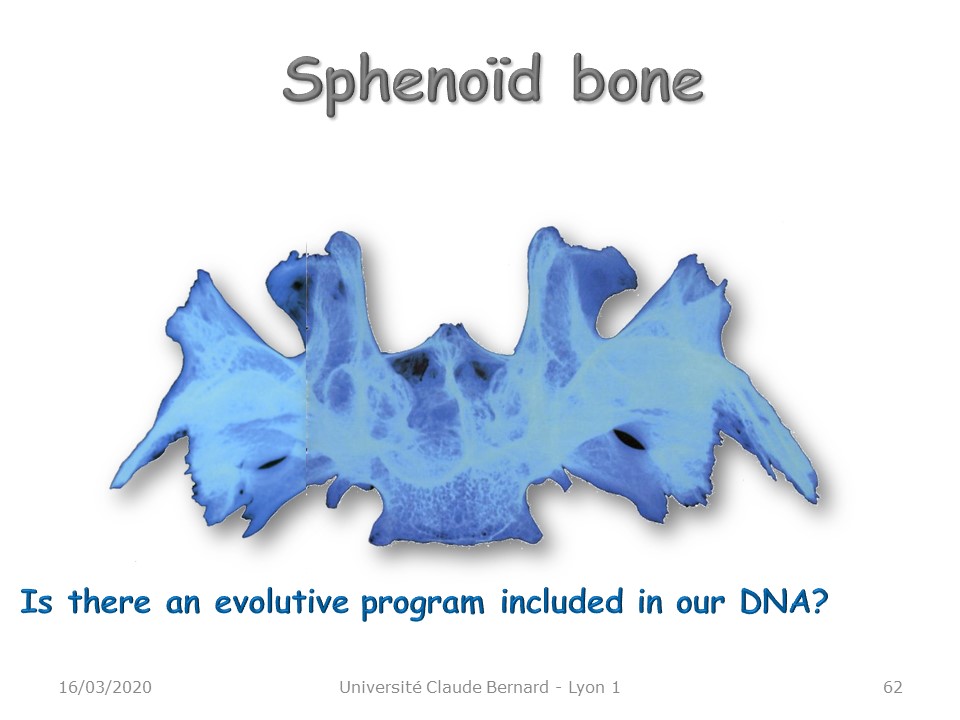 |
The sphenoïd bone undergoes many modifications and this leads to wonder if there is an evolutive program included in our DNA |
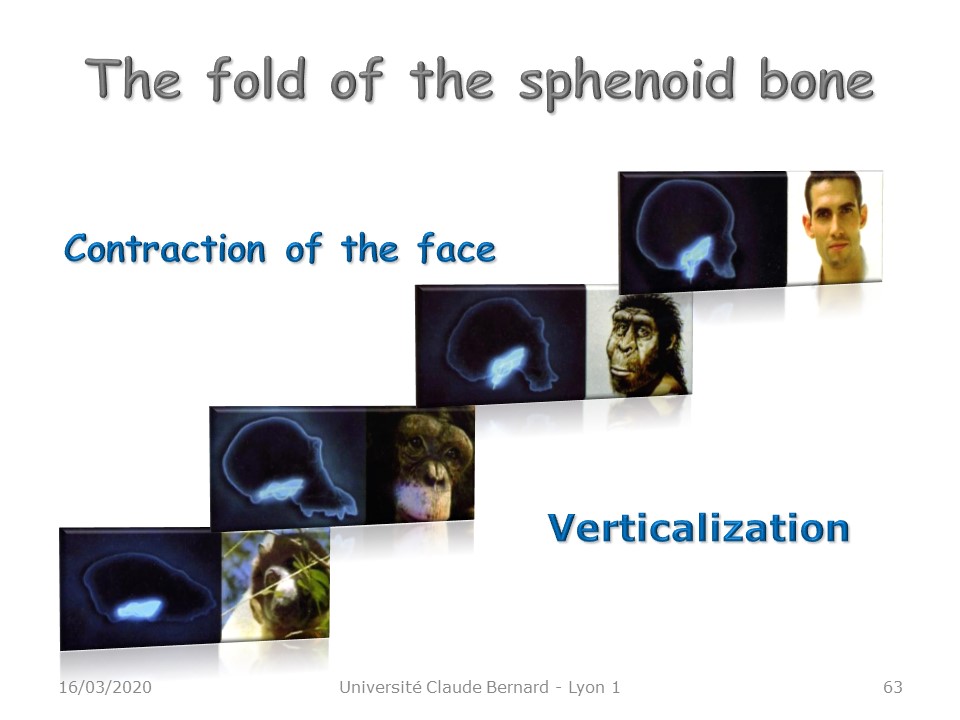 |
The sphenoid is verticalizing slowly while the face is contracted until it reaches an orbital vertical plane. |
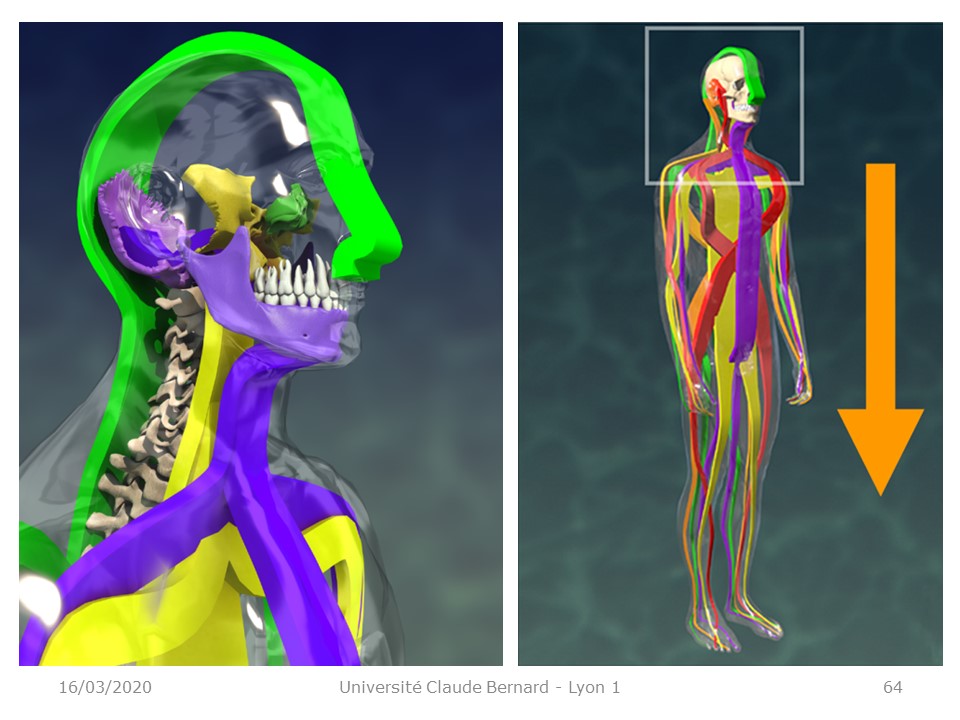 |
The anterior chains are inserted on the lower maxilla and the posterior chains on the upper maxilla. The deep front line is inserted at the level of the sphenoid. |
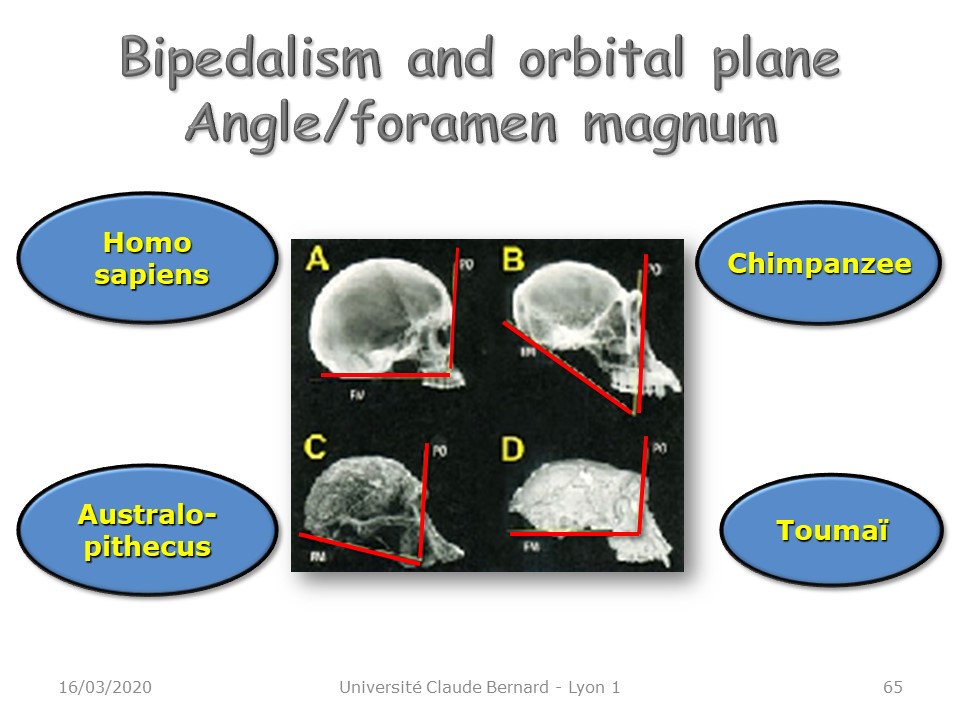 |
The homo sapiens has an orbital and a foraminal plane at 90° really close to Toumaï’s, whereas chimpanzee and australopithecus have a really closed-angle. |
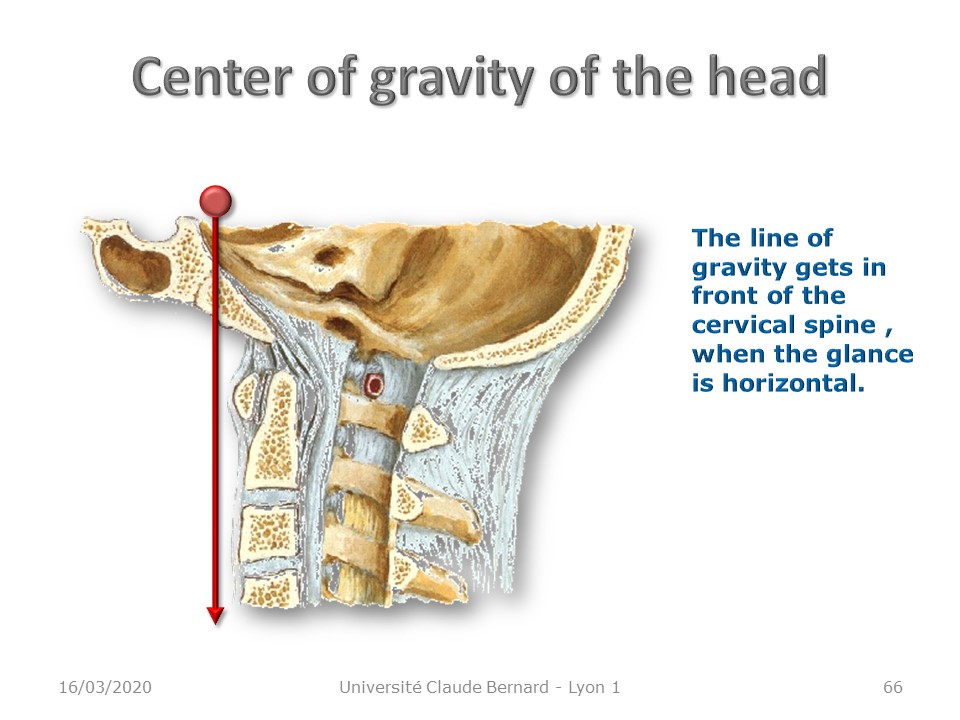 |
When the look is horizontal, the line of gravity gets in the front of the cervical rachis. The muscular tensions are balanced when the glance is 10° high, like for instance at the cinema. |
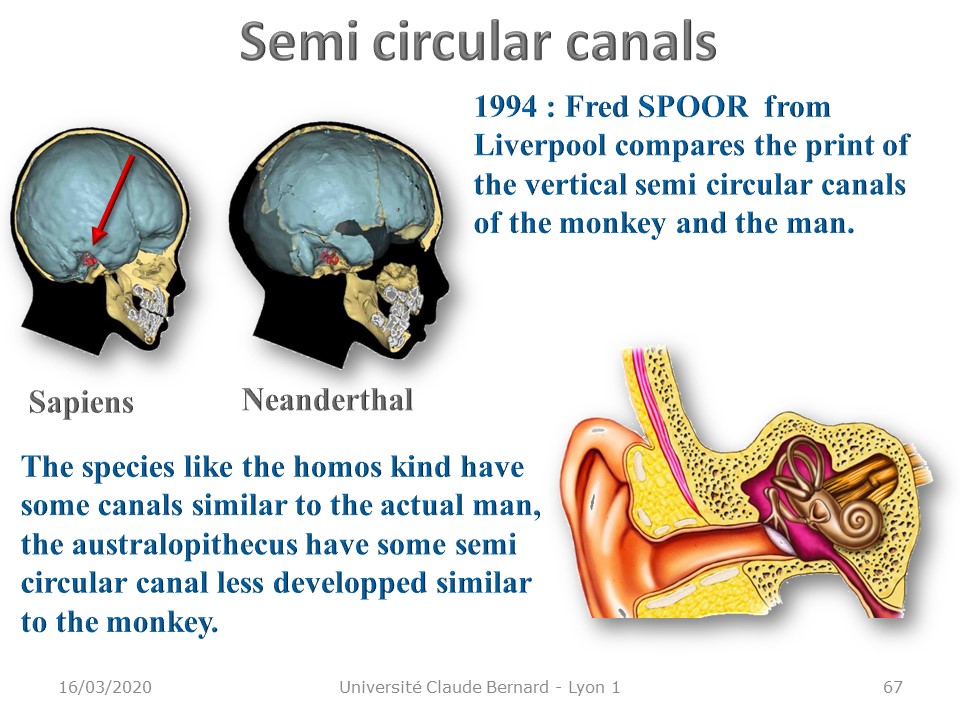 |
In 1994 Fred Spoor from Liverpool compares the print of the vertical semi circular canals and notices a variation from the monkey to the homo sapiens. The australopithecus have a print similar to the one of the actual big monkeys. The semi circular canals are perfectly horizontal when they look two meters forward, this is logic when we consider the role of the postural system during the walking or the running. |
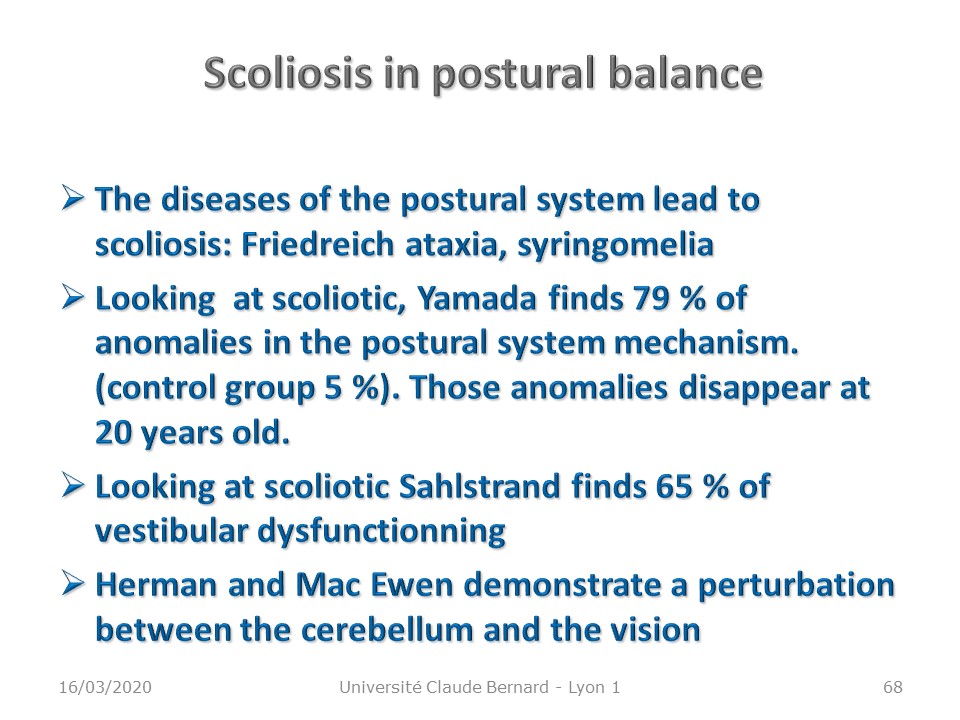 |
|
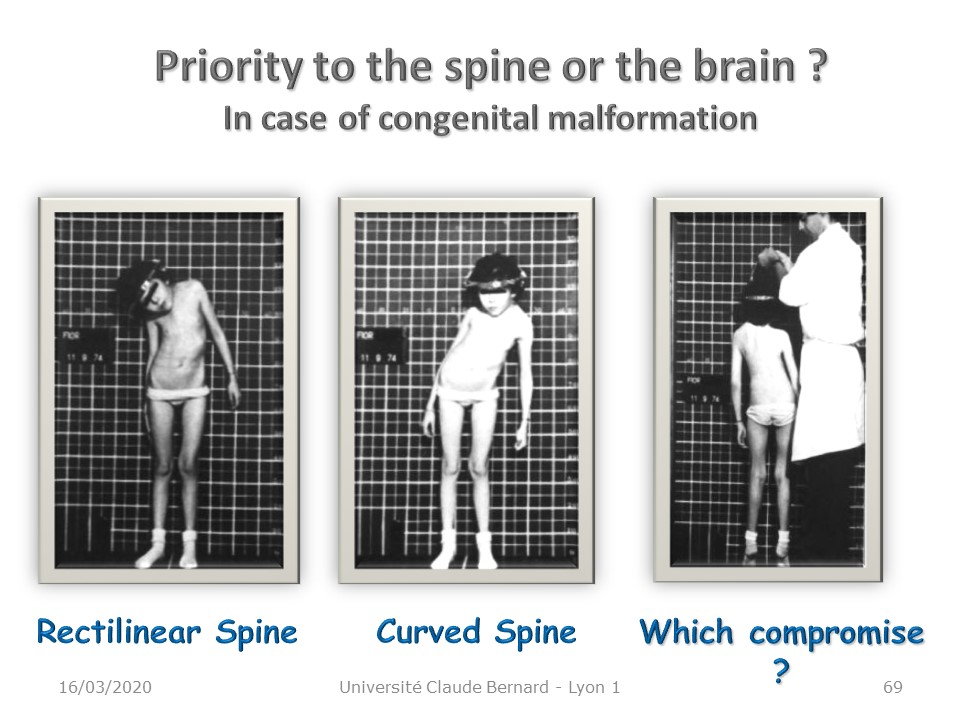 |
Two vertical cycles to one lateral one. When there are some cervival congenital deformation, like this child, there are two possibilities: Either line the rachis on a vertical with an inclination of the head and the glance, Either create an underlying scoliosis to maintain a horizontal look. This solution is the one chosen by the child. The head is a priority. |
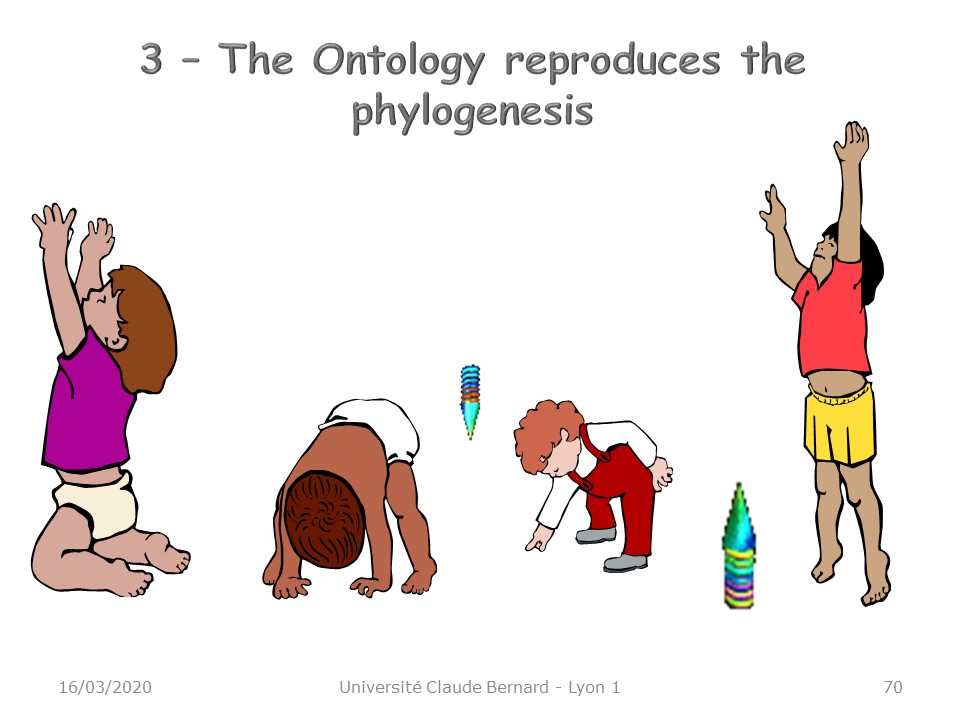 |
The observation of the child reproduces the evolution of the phylogenesis of bipedalism. |
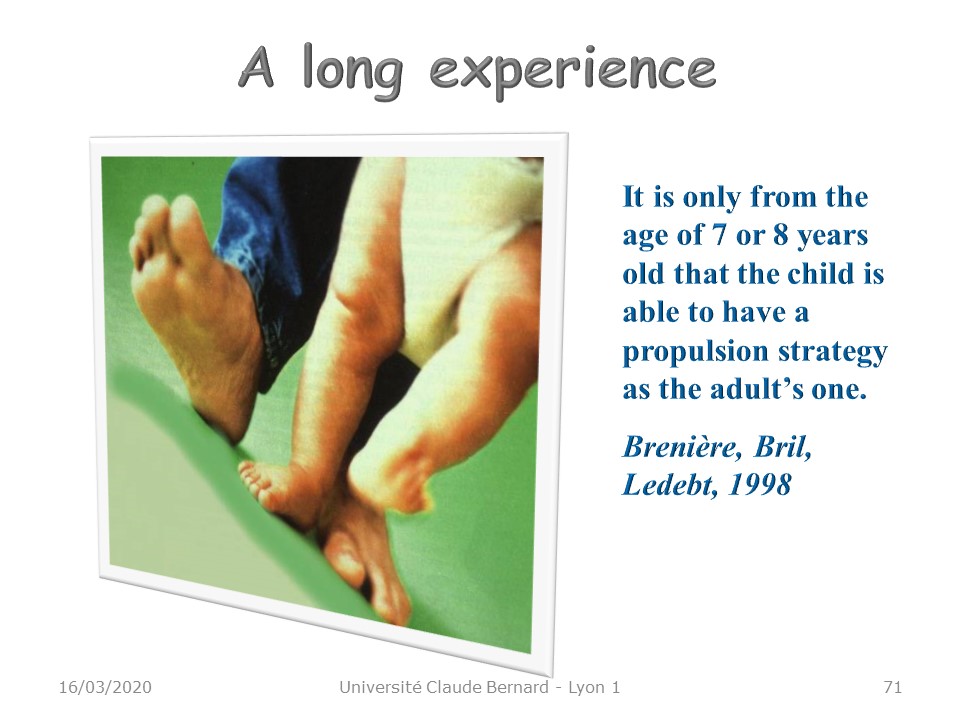 |
The bipedia and the verticalization of the little child gives us an idea of the evolution. Brenière, Bril and Ledebt from the research center of Marseille showed that it is only from the age of 7 that the child is able to produce a propulsion strategy like the adult’s one. A 2 years old runs after its center of gravity and is unable to unroll the step. |
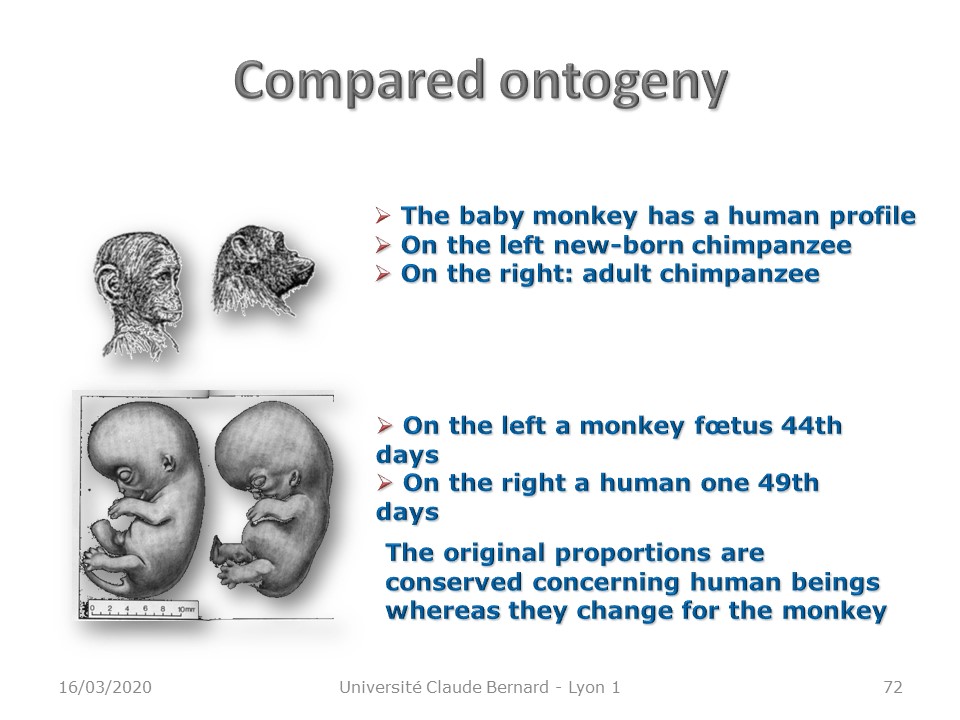 |
If we compare the evolution of a man’s fœtus and a monkey’s one we can note that they look alike around the 45th days . Furthermore at birth, the face morphology of the chimpanzee is very close from the homosapiens’ and is going to change when they become adults. The original proportions are conserved concerning human beings whereas they change for the monkey. We can therefore imagine an older bipedia which would have been conserved and developped by the homo-sapiens, whereas autralopithecus and actual monkeys are only a non evolution from this original bipedia. |
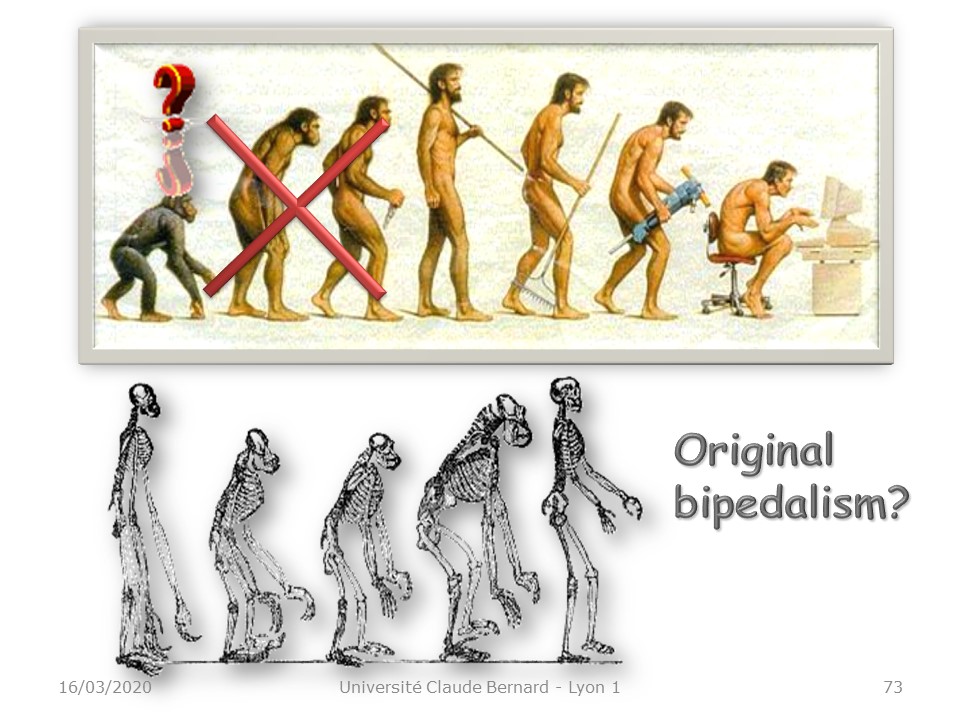 |
Many scientists today are convinced that bipedalism is very old in primates. |
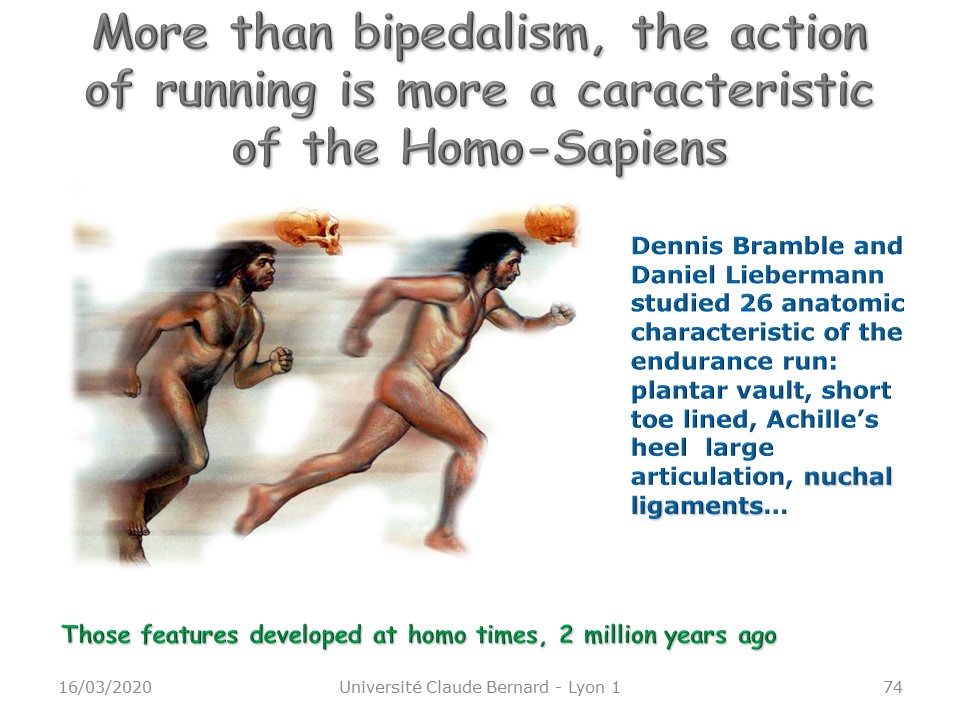 |
More than bipedia, running is a caracteristic of the homo-sapiens. Denis Bramble and Daniel Liebermann studied 26 anatomic characteristic of the endurance run: plantar vault, short toe lined, Achille’s heel, large articulations, nucal ligaments… Those features developed at homo-times 2 million years ago. We found in the Dordogne’s crave where Cro-Magnon lived (sapiens sapiens) black stones from the pyrenees 400 Km away. Contrary to the Neandertal man he is able to travel far away to make a necklace for his wife. |
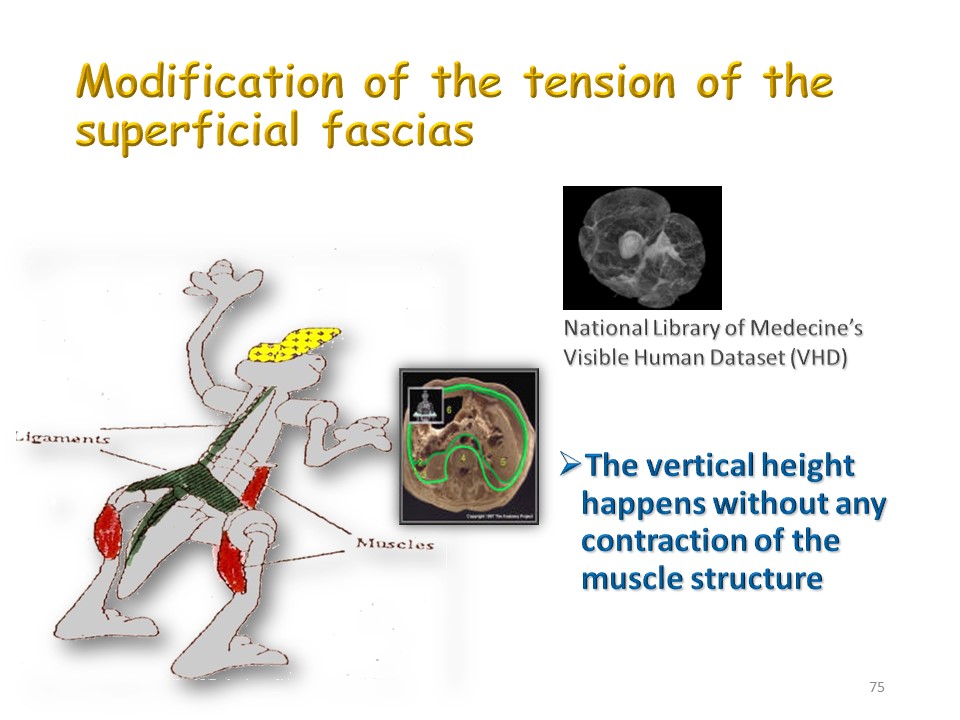 |
We note, besides, a transformation of some muscle structure into ligaments especially at the cervical and lombo-pelvic level. The tension of the superficial fascias enables a vertical height without any active contraction of the muscle structure. . |
 |
.
|
 |

To register for Certification, please contact SSOL

|